Introduction By Tom D. Crouch
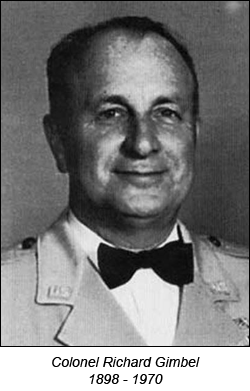 By 1942, Tennyson’s prophetic vision of war and peace in an air age had long since come to pass. The Blitz, the "ghastly dew" of German bombs that had rained down on London in the high summer and fall of 1940, was over. The Luftwaffe struck Bath, Norwich, Exeter, and other provincial cities in a series of "Baedeker raids," while the capital enjoyed several months without a night alert. That June, officials reduced the number of West End tube stations outfitted as air raid shelters from ten to four as a cost-saving measure. The "little Blitz" of 1944, and the terror of the flying bomb campaign, lay in the future. For the moment, however, beleaguered Londoners could breathe a little easier and grow accustomed to sleeping through the night.
By 1942, Tennyson’s prophetic vision of war and peace in an air age had long since come to pass. The Blitz, the "ghastly dew" of German bombs that had rained down on London in the high summer and fall of 1940, was over. The Luftwaffe struck Bath, Norwich, Exeter, and other provincial cities in a series of "Baedeker raids," while the capital enjoyed several months without a night alert. That June, officials reduced the number of West End tube stations outfitted as air raid shelters from ten to four as a cost-saving measure. The "little Blitz" of 1944, and the terror of the flying bomb campaign, lay in the future. For the moment, however, beleaguered Londoners could breathe a little easier and grow accustomed to sleeping through the night.
The tables were turning. Night after night, the men of Royal Air Force's Bomber Command set out from airfields all along the North Sea coast of Britain, determined to carry the war to the cities of the Reich and Fortress Europa. Moreover, Londoners were becoming thoroughly familiar with American accents and uniforms. The 8th Air Force struck its first blow against the Axis in August 1942, when a dozen B-17s attacked the railway yards at Rouen, France. The first U.S. strike against a target in Germany was still six months away.
If life in London seemed a bit more cheerful and less threatening in the spring of 1942, it was still impossible to escape the war. On the evening of June 13, nineteen residents of Gurney Street, Southwark, died in the explosion of a UXB (unexploded bomb) that had remained hidden in the rubble for thirteen months. Authorities speculated that the vibration of trains moving through nearby Elephant and Castle station had detonated the bomb. Relatively small raids followed that summer and fall. Civil defense authorities were particularly concerned about the appearance of a new and more powerful incendiary bomb.1
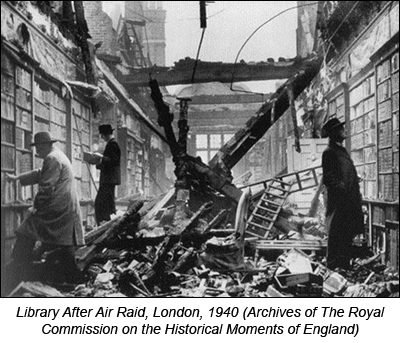 Lt. Col. Richard Gimbel, an administrative officer with the 8th United States Army Air Force (USAAF), arrived in England on July 1, 1942. Like other Americans, he had watched London burning in the newsreels and had listened to Edward R. Murrow's broadcasts from the city during the height of the Blitz. Now he could witness the devastation for himself.
Lt. Col. Richard Gimbel, an administrative officer with the 8th United States Army Air Force (USAAF), arrived in England on July 1, 1942. Like other Americans, he had watched London burning in the newsreels and had listened to Edward R. Murrow's broadcasts from the city during the height of the Blitz. Now he could witness the devastation for himself.
Gimbel, one of America's leading rare book collectors, must have been particularly saddened by the destruction of the Paternoster Row neighborhood, the traditional center of British publishing and the book trade. An estimated 6 million volumes, ranging from new books waiting distribution to rare surviving examples of the earliest printed volumes, had gone up in flames on the night of December 29, 1941, when bombs rained down on the quarter square mile of crowded streets in the shadow of St. Paul's Cathedral.
“There was nothing left to recognize,” one observer noted as he walked through the area the next morning. “Such a scene of destruction I have never seen or imagined.”
In publishers’ basements . . . glowed and shuddered the remnants of a million books. Gusts of hot air and acrid smoke blew across the streets . . . . From Warwick Square on the west to Ivy on the east, from Paternoster Row to Newgate Street, there lies now an undulating sea of broken yellow bricks. As I picked my way gingerly across from brick to brick, hot gusts of sulphurous fumes from buried fires seeped up between my feet; desultory flames played on the remains of a rafter here, or a floor joist there; and on either side the smoking causeway fell sharply away into cavernous glowing holes, once basements full of stock, now the crematories of the City’s book world.2
The smoke had cleared by the time Richard Gimbel arrived in England six months later, but one of the most historic neighborhoods in the City of London remained an urban wasteland of broken glass and brick. Soon thereafter, Gimbel noticed an advertisement for a London bookshop that, in spite of the best German efforts to the contrary, would be “Open for Business as Usual.” Impressed by the spirit of the bookseller, Gimbel called at the shop and looked around for something to purchase. Noticing that his customer was a USAAF officer, the shopkeeper produced a box filled with an assortment of books on aviation. Richard Gimbel, a veteran bibliophile who had already built three world-class book collections of American and English authors, had found a new world to conquer.3
The Merchant Prince
Richard Gimbel was born in Atlantic City, New Jersey, on July 26, 1898, the son of Ellis A. and Minnie Mastbaum Gimbel, and the grandson of Adam, who had journeyed from Bremerhaven to New Orleans in 1835 as an impoverished teenager. This first American Gimbel earned his living as an itinerant peddler, traveling up and down the Mississippi Valley until 1842, when he established his first dry goods store, The Palace of Trade, in the small town of Vincennes, Indiana.
Adam met and married Fridolyn Kahnweiler, the 17- year-old daughter of a German-Jewish family, during a buying trip to Philadelphia in 1847. The couple would produce fourteen children over the next twenty-four years. The Gimbel empire was to be a family enterprise. Within a few years of his marriage, Adam was operating four stores in Vincennes and a fifth in Danville, Illinois. One after another, each of the seven surviving Gimbel brothers would learn the ropes working in one of the growing chain of family stores. “Others may have had their paid helpers and assistants,” Adam Gimbel explained, “I have had my seven sons.”4
The Gimbels began their period of serious expansion in 1887, when Jacob and Isaac, the eldest of Adam’s merchant princes, established a department store in Milwaukee. Five years later, father and sons purchased the Granville B. Hayes store in Philadelphia, where they installed the first escalators in the city, created a much publicized merchandise testing bureau, and established a reputation for “truth in advertising.” Ellis, the youngest son, and Richard Gimbel's father, established the New York store, the flagship of the family fleet, in 1910.5
“I was fortunate in being born with a sort of silver spoon in my mouth,” Richard Gimbel once explained.6 He grew up in a family already famous for its bargain basement; a feud with Macy's that had been manufactured for its public relations value; an annual holiday parade in Philadelphia; and lavishly decorated store windows at Christmastime. Education was taken very seriously in this family. Young Richard attended Philadelphia's prestigious School of Pedagogy and graduated from Central High School, an institution famed for its high standards and classical curriculum. He entered Yale in 1916.
Richard Gimbel was a brilliant student and something of a character. “From the time he was a child,” his cousin Rose recalled many years later, “he loved to give the impression he was crazy.” He was, in any case, always eager to make a buck. As an undergraduate, he established a tutoring service, complete with a money- back guarantee of the sort people had come to expect from Gimbel's. Even with four months off in 1918 for service as a lieutenant with the 310th Field Artillery, 79th Division, he was still able to qualify for Phi Beta Kappa and graduate with the class of 1920.7
Richard Gimbel's first important assignment in the family business was to plan and supervise construction of a new $18-million Philadelphia store that opened in 1927. He rose to the position of vice president of the Gimbel Corporation and succeeded his father as president of the Philadelphia store. During these years the company's Philadelphia operations averaged annual sales of $100 million. This phase of Gimbel's career came to an abrupt end in 1935, when he lost a management dispute with his older cousin Bernard, who insisted on placing Arthur C. Kaufmann, scion of a Pittsburgh retail family, in effective command of Gimbel's Philadelphia operation. “I'm very fond of Bernard,” Gimbel explained years later:
There was a heated proxy fight and the whole thing blew up in smoke. We just had a basic disagreement; he and his group wanted outsiders in the management, and I didn't. I wanted the business run by the family; there were fifteen Gimbels in it at one time. That way, you could take longer vacations and sort of rotate. I know that some Gimbels are better at business than others, but I believe that owner management makes up for lack of brilliance, and anyway my motto is “Let the strong carry the weak.”8
Clearly, Richard Gimbel, speaking many years later to a reporter from the New Yorker, was putting the best possible face on the matter. Having lost the fight, he was not only forced out of company management; for a time he was barred from entering the Philadelphia store.9
Retaining a large block of Gimbel's stock, but unable to use the company name, Gimbel moved to Miami, Florida, in 1937, where he took over Richard's Department Stores. He diversified his business interests as well, investing heavily in both the broadcasting industry and the IBM Corporation. Although Richard Gimbel took business very seriously, it was clear that he reserved his deepest enthusiasm for his collection of rare books and manuscripts. Beginning not long after his graduation from Yale, the young businessman had begun to build the first of his four great collections, three of which were loosely connected to his interest in the history of Philadelphia.
Gimbel took special pride in having gathered the world's finest collection of the writings of Thomas Paine, the radical thinker who had provided a rationale for American independence. Fascinated by Edgar Allan Poe, who had lived and worked in Philadelphia between 1838 and 1842, Gimbel built an enormous collection of U.S. and foreign editions of his work. Poe met Charles Dickens when the English author visited Philadelphia in March 1842. Perhaps as a result of this encounter between two literary giants, Gimbel began a world-class collection of Dickens' books and magazine serials, with an emphasis on materials autographed by the author.
Asked to provide a list of his three leading credit references during the years after World War II, Gimbel named Philadelphia's two leading banks–and a Walnut Street bookstore. Brig. Gen. George V. Fagan, a former director of the Air Force Academy Library, explains that Gimbel was a sophisticated bookman with a deep understanding of the inner workings of the rare book trade:
For many years, Col. Gimbel had been a client and admirer of another Philadelphian, Dr. A.S.W. Rosenbach, the unexcelled doyen of American rare book dealers and collectors. From Dr. Rosenbach, Richard Gimbel had acquired a sense of the pure joy and excitement of collecting as well as an understanding of the significance of rare materials in the realm of scholarship. Gimbel was a life-long member of the American Bookman's Association and regularly attended national and international meetings. At these gatherings, rare materials were displayed, sold and traded among dealers throughout the world. Richard was also a very active member of the Grolier Club which is made up of wealthy collectors and bibliographers as well as dealers.10
Prior to World War II, Gimbel also turned his attention to the other great interest of his life–flying. His love of aviation began in 1910, when as a boy of twelve he witnessed two great events that he would never forget. On April 23, while visiting London with his parents, young Richard watched English aviator Claude Grahame-White roar away from the Park Royal, steering his Farman biplane through the early morning fog and darkness in an unsuccessful attempt to win the £10,000 Daily Mail prize for the first flight from London to Manchester. Gimbel's father was one of those who established a $10,000 prize for the first flight from New York to Philadelphia and back. On June 13, 1910, Richard shook the hand of the man who won that prize, Curtiss aviator Charles K. Hamilton, and proudly announced that he planned to become a pilot himself.
He made good on that promise three decades later. The senior members of the Gimbel family did not approve of flying lessons for young associates with positions of responsibility in the firm. Once he was on his own, however, Gimbel lost no time in earning his license (#39293) and purchasing a Stinson Reliant (N14187). He flew on business and to savor the sheer joy of spending a few hours in the sky. Eventually he acquired two smaller Fairchild aircraft and became active in aviation affairs, serving as chairman of the aviation committee of the Miami Chamber of Commerce; director of the Miami Air Pilots Association; and chairman of the contest committee of the Cuban National Air Races.11
Richard Gimbel launched his third and final career in 1940, when he transferred from his position as a lieutenant colonel in the field artillery reserve to the U.S. Army Air Corps. Called to active duty on June 15, 1941, he commanded various administrative and service units prior to being ordered to England with the 8th Air Force Service Command. Initially, Gimbel was assigned to duties as an officer in charge of reception centers and rest homes. He also attended aerial gunnery school at the 11th Combat Crew School in Bovington, England.
Gimbel had been promoted to full colonel, earned his wings as a USAAF service pilot qualified to fly single- and twin-engine aircraft, and had almost completed his twelve-month tour of duty in England before he tasted combat. Early on the morning of June 15, 1943, he flew as a nose gunner and observer with the 510th Bomb Squadron, 351st Bomb Group, on a mission against Le Mans, France, that was aborted because of poor visibility over the target.
Things were a good deal more exciting one week later when Colonel Gimbel flew aboard one of the six aircraft that the 510th contributed to the first 8th Air Force raid on targets in the Ruhr Valley. The Luftwaffe was waiting for them. The group lost one aircraft. Another limped home with heavy damage. The group’s gunners were credited with destroying seventeen enemy aircraft that day. Richard Gimbel claimed responsibility for one of those fighters–an FW190. Four days later, Capt. Clark Gable took Gimbel's place as an observer-gunner flying off to war with the 510th Bomb Squadron.12
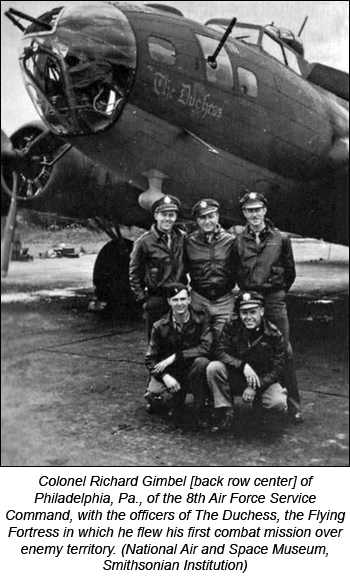 When Gimbel returned from England in July 1943, USAAF officials assigned him to administrative and personnel duties where he could put his extraordinary business skills to work solving the procurement and logistical problems of the first global air war. Having qualified as a service pilot while still in Europe, Gimbel was assigned to flying duties with the 13th, 20th, and 10th Air Forces following World War II, then returned to his alma mater as Professor of Air Science in 1951. Retiring from the U. S. Air Force two years later, he remained at Yale as curator of Aeronautical Literature until his death in 1970.13
When Gimbel returned from England in July 1943, USAAF officials assigned him to administrative and personnel duties where he could put his extraordinary business skills to work solving the procurement and logistical problems of the first global air war. Having qualified as a service pilot while still in Europe, Gimbel was assigned to flying duties with the 13th, 20th, and 10th Air Forces following World War II, then returned to his alma mater as Professor of Air Science in 1951. Retiring from the U. S. Air Force two years later, he remained at Yale as curator of Aeronautical Literature until his death in 1970.13
During the last three decades of his life, Richard Gimbel focused increasing time, energy, and enthusiasm on the acquisition of rare items of aeronautica. Fascinated by the contents of the first box of aeronautical items purchased from the bomb-damaged bookstore, he decided to begin building a new collection that would link his deep interest in rare books with his love of aviation. He scoured the bookshops and auction houses of wartime London, taking great delight in shipping coffin-shaped crates filled with aeronautical books home to his wife. In addition, he commissioned Maggs Brothers and Bernard Quaritch, English rare book dealers with a long interest in aeronautica, to seek out fresh treasures for his new collection.
Gimbel cast a wide net, creating the world's finest collection of materials illuminating five millennia of persistent human dreams and efforts to achieve flight. “I've never catalogued it,” Gimbel admitted to a New Yorker reporter who inquired about his collection,
but I must have over one hundred thousand items now, including books, manuscripts, pictures, Babylonian seals, coins, stamps, postcards, fans, cigarette cards, Siege of Paris balloon mail, carrier pigeon mail, aeronautical dinner plates, watches, snuff boxes– everything reflecting man's endeavor to fly and his interest in flight. Everything up to the Wright brothers, that is to keep from being swamped, I end the collection there. As it is, people send me doorknobs and shower curtains with balloons on them, and I'm in constant communication with about four hundred dealers, all over the world.14
His timing was impeccable. Economic conditions in postwar Europe increased the amount of rare eronautical material on the market. As a knowledgeable and seasoned bibliophile who had established a deep and long-standing relationship with the leading rare book dealers of the United States and England, Gimbel was willing to pay top dollar.
He took a great interest in references to flight in the earliest printed books, which are perhaps better represented in his library than in any other private collection of aeronautica. He also learned from the experience of earlier collectors like Bella Landauer, a New York matron who pioneered new collecting areas, including advertising ephemera, song sheets, and juvenile books with aeronautical themes. Recognizing the importance of rocketry and space travel in the postwar world, Gimbel would include in his library volumes related to that subject from the earliest volumes on black powder rocketry and pyrotechnics to volumes of science fiction that had inspired the birth of the space age. By 1955 Gimbel's growing collection of aeronautica was already recognized as the finest in the world.
Gimbel spent the last two decades of his life in New Haven. “I was retired, as a full colonel, in 1953,” he explained to an interviewer from the New Yorker, “and stayed on here, with the Library, of which I am a trustee.”
The university offered me space, a curatorship, and two bursary students to work on my collection. I have a house near the [Yale] Bowl, where my wife and I live with our two youngest children–thirteen year old girls, identical twins. We have two grown- up sons and three married daughters. I'm a Fellow of Pierson College; I attend some classes that interest me; I gave a dinner for forty professors last night; and all I can say is that my cup runneth over.15
He enjoyed the prestige that accompanied a formal relationship with a great university. Moreover, Yale officials provided safe and secure storage for his books and enabled him to publicize the treasures of his collection through the medium of two major exhibitions staged in university library gallery space. “Five Thousand Years of Going Up: An Exhibition of Aeronautical Books and Prints Ending with the Discovery of the Secret of Flying by the Wright Brothers,” opened in December 1953 in honor of the 50th anniversary of the invention of the airplane and ran through January 1954. Four years later, at the height of excitement over the launch of Sputnik I, Gimbel produced a second exhibition on the prehistory of the space age, including such rare materials as his original 1493 first published edition of Vera Historia, the story of a voyage to the moon by the Greek satirist Lucian.
Richard Gimbel died of a heart attack near Munich, Germany, on May 27, 1970. He was among friends, visiting Europe on a trip sponsored by the Grolier Club of New York, the nation's most prestigious society of rare book collectors. He died engaged in what had always been his favorite pursuit.
J. Pierpont Morgan, Harry Elkins Widener, Henry E. Huntington, Henry Clay Folger, and other leading American philanthropist-collectors had achieved a sort of immortality by establishing great public or private research libraries named for themselves. Gimbel preferred to will his treasures to a series of carefully selected research libraries with strong supplementary collections that would extend the scholarly value of his materials. The Thomas Paine Collection, for example, went to the American philosophical Society, a Philadelphia institution with extraordinarily strong holdings in the area of early American history. Gimbel, who decorated his Yale office with a stuffed raven, willed his Poe materials to the Edgar Allan Poe Museum and Library, a Philadelphia institution that he had established some years before. He boasted to friends that he had succeeded in getting Poe's name into the Philadelphia telephone book.
He rewarded Yale University, where he served on the library board of trustees and held an appointment as curator of aeronautical literature for almost twenty years, with the gift of his Charles Dickens collection. Yale had lost the real prize, however. The treasures of the Colonel Richard Gimbel Aeronautical History Collection were destined for the Air Force Academy.
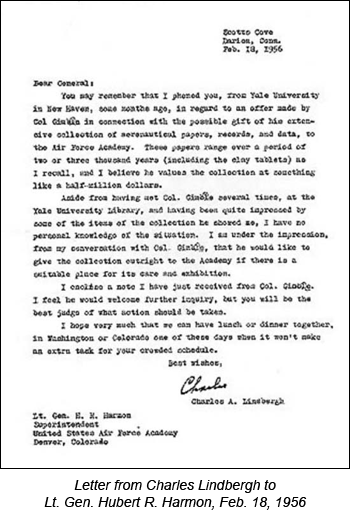 On the morning of April 11, 1955, Charles Augustus Lindbergh telephoned Lt. Gen. H.R. Harmon with news that “the finest and most valuable collection of aeronautical documents in the world, covering a period of 5,000 years–up to the Wright brothers' first flight,” might be available to the Air Force Academy. Lindbergh, a resident of Darien, Connecticut, who was in the process of donating his own papers to Yale, had made the acquaintance of Richard Gimbel.
On the morning of April 11, 1955, Charles Augustus Lindbergh telephoned Lt. Gen. H.R. Harmon with news that “the finest and most valuable collection of aeronautical documents in the world, covering a period of 5,000 years–up to the Wright brothers' first flight,” might be available to the Air Force Academy. Lindbergh, a resident of Darien, Connecticut, who was in the process of donating his own papers to Yale, had made the acquaintance of Richard Gimbel.
Just a year before, Lindbergh and General Harmon had served on the five-man committee created to advise Secretary of the Air Force Harold Talbott on a site for the Academy. Now Harmon was serving as the first superintendent of the academy-in-the-making, with headquarters at Lowry Air Force Base, near Denver, Colorado, while work was underway on the new facility at the foot of the majestic Rampart Range of the Rockies, just outside Colorado Springs.
As a retired officer who had commanded the Air Force ROTC detachment at Yale, Gimbel was enthusiastic about the notion of an Air Force Academy. Moreover, he was certain that his collection of aeronautica could be of extraordinary value in connecting Academy cadets to a dream of flight as old as humanity and a rich tradition of airmanship and innovation almost as old as their nation. Familiarity with the cultural and historic roots of aviation, he felt, should be an important element in the professional education of the cadets.
Searching for a suitable repository to house his personal papers, Lindbergh had visited Yale's Sterling Library at the suggestion of his friend Harry Guggenheim, a Yale alumnus. It was only natural that the library staff introduce their guest, the world's most famous pilot, to the local aviation celebrity and honorary curator of aeronautical literature. Surviving correspondence indicates that Gimbel immediately asked Lindbergh to assist him in opening discussions with Air Force leaders. Gimbel pursued serious negotiations regarding the donation of his collection to the Academy through the early 1960s and remained in touch with Academy officials until the time of his death.
Gimbel's correspondence files reveal that he was careful to keep Yale library officials fully informed of his discussions with the Air Force. As the negotiations dragged on for years with no resolution, Yale officials who sought to hold on to the collection must have begun to relax. Gimbel had always indicated that the location of his collection during his lifetime and its ultimate disposition were two distinct matters, however. He remarked on several occasions that he intended to donate his aeronautical collection “to the institution best qualified to house it, preserve it, exhibit it, and make the best use of it for scholars.”16 In willing his collection to the Air Force Academy, Gimbel accomplished a great deal more. The Gimbel collection was destined to become part of the intellectual life of the Academy.
Ancient Wings
When Yale's curator of aeronautical literature was giving a tour of his collection or planning an exhibition of the materials, he liked to move chronologically. “Well, I thought at first that I'd . . . start with the Bible–angels, you know–but I found that angels in the Bible didn't get wings until quite late; the cherubim guarding the tree of life, in the third chapter of Genesis, don't have any in the early illustrations,” he explained.
So I started with the Babylonian legend of Etana. Etana, a prince who could not have children and was worried about high taxes, was advised by holy men to consult an eagle. He found a beat-up eagle on a mountaintop, nursed it back to health, and talked it into flying to Heaven with him on its back. I haven't been able to get an Etana seal myself, but the Morgan Library has one and was kind enough to give me a wax impression of it.7
In fact, Gimbel did manage to acquire a handful of the seals and stamps produced by the peoples of southern Mesopotamia. The Academy archivist once allowed me to hold the oldest of these tiny dark stone cylinders in my white-gloved hand. It is as old as civilization, dating to 2700 B.C.E., and one of the earliest representations of the symbolic power of wings.
When the seal is rolled onto a strip of moist clay, repeated images of an eagle with outspread wings appear, separating a series of naked men, wearing what specialists recognize as the belt of a hero, holding two goats aloft by their heels. The precise meaning of this image is unclear. Representations of Etana and his magical eagle would not appear for another two centuries. This might be Anzu, the lion-headed eagle who obtained the tablets of life from the air-god Enlil, or the Imdugud-bird, who decreed the fates and befriended the hero Lugalbanda.18
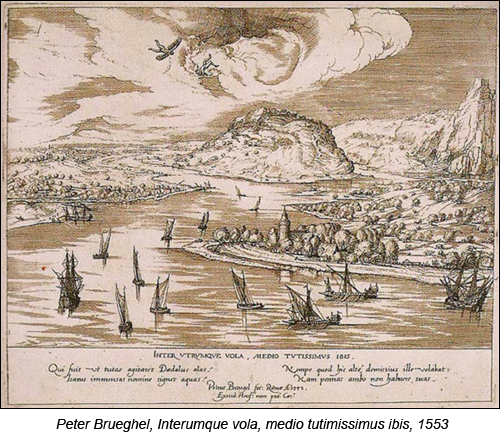 It is enough to know that from the very dawn of civilization winged creatures were thought to link the mortal world with the power of the gods. “The natural function of the wing is to soar upwards and carry that which is heavy up to the place where dwells the race of gods,” Plato explained in Phaedrus. “More than any other thing that pertains to the body it partakes of the nature of the divine.”19
It is enough to know that from the very dawn of civilization winged creatures were thought to link the mortal world with the power of the gods. “The natural function of the wing is to soar upwards and carry that which is heavy up to the place where dwells the race of gods,” Plato explained in Phaedrus. “More than any other thing that pertains to the body it partakes of the nature of the divine.”19
From the beginning, we placed our gods in the heavens and regarded flight as a symbol of supernatural power. It is scarcely surprising that the mythologies of the ancient world are filled with stories of heroes who traveled into the sky to commune with the gods.
The oldest printed book in the Gimbel collection, Historia Alexāndri Magni [The romance of Alexander] (1489), tells of the legendary flight of Alexander the Great, who is said to have been carried aloft by winged griffins harnessed to a basket. This is the first published version of a tale that had inspired ancient poetry and medieval illuminated manuscripts. Alexander was by no means the only hero who ventured aloft by hitching a ride with birds or mythical flying creatures. The Gimbel shelves contain rare accounts of Etana, the Babylonian eagle tamer; K'ai Ka'us, the Persian monarch who harnessed himself to eagles; and Sinbad, the hero of A Thousand and One Nights, who tied himself to the leg of a giant Roc.
There can be no doubt as to the identity of the classic myth of the air, however. The story of Icarus and Daedalus is very different, and much more powerful, than what had come before. Appropriately, the oldest printed illustration in the Gimbel collection is a woodcut entitled “The Fall of Icarus.” Prepared by the German master Albrecht Dürer for Friedrich Riedrer's Spiegel der waren Rhetoric (1493), it is also the very first image of human beings in flight to appear in a printed book.
The Roman poet Ovid offered the best account of the legend of Daedalus, the ingenious artificer commissioned by Minos, king of Crete, to design and build a great labyrinth, or maze, in which to imprison the monstrous bull, the Minotaur. Falling from the king's favor, he was imprisoned in a tower with his young son, Icarus. Unable to escape in any other way, Daedalus collected feathers and worked them into wings with great care. The larger feathers were sewn to the frame with twine, the smaller attached with wax. When the work was complete, “he bent them with a gentle curve, so that they looked like real birds’ wings.”20
Daedalus cautioned Icarus not to fly too low, where "the damp will clog your wings," or too high, where the sun would melt the wax. Thomas Bulfinch, the Harvard graduate and Boston bank clerk who published a popular retelling of the classic myths in 1855, imagined what an impact the sight of these first two men in the sky must have had on those who saw them: “As they flew the ploughman stopped his work to gaze, and the shepherd leaned on his staff, and watched them, astonished at the sight and thinking they were gods who could thus cleave the air.”21
They had flown past the islands of Samos and Lesbos, when Icarus climbed too close to the sun and fell to his death. Daedalus retrieved the body and buried it on an island west of Samos. He named the island Icaria and the body of water surrounding it the Icarian Sea. Daedalus continued his aerial journey to Sicily, where he dedicated a temple to Apollo in which he hung up his wings as a divine offering.
The story is memorialized on modern maps–Icaria and the Icarian Sea–testimony to the antiquity and popularity, if not the reality, of the legend. It is by no means difficult to understand the depth and power of this myth. This is not some tall tale about a fellow who believes that he can be drawn through the air by a team of birds. Daedalus relies on his ingenious brain and clever hands to design artificial wings with which to trespass on the domain of the gods. But this is far from being a story of unalloyed triumph. The ancients understood that those who would imitate the gods must be prepared to suffer their wrath. Later generations would understand the extent to which the legend underscores the risks involved in the technological enterprise.
Dürer's historic illustration is a forceful portrayal of the very moment of disaster. A bearded Daedalus, flying in formation with two ducks, glances down to see Icarus plummeting into a sea that is dotted with islands, each capped by a castle. The young man's left hand has just broken the surface, preceded by two loose feathers and a duck with folded wings whose head has already disappeared beneath the water. Clearly, the dive that will prove fatal to Icarus is quite natural for the duck. It seems to be Dürer's artistic restatement of the widespread assumption: “If God had meant humans to fly, He would have given them wings.”
Like other myths that touch a fundamental cord in the human psyche, the story of Icarus and Daedalus has inspired generations of artists. In addition to the Dürer woodcut, the Gimbel collection contains illustrations of the story in a wide variety of media. “The Flight of Icarus,” for example, is a deeply sculpted bronze medal produced by artist Joseph Sheppard in 1992 for the American Society of Medalists. The obverse illustrates the moment of wonder as father and son rise into the air. The reverse shows a terrified Icarus, shorn of his wings, falling toward the sea.
Gimbel's wonderful collection of sheet music on aeronautical themes includes the sonnet Icare (1840) by French composer Victor Masse. The cover shows the body of Icarus lying on the rocks, his wings smashed and broken. Gimbel also acquired a large stippled engraving titled “Daedalus & Icarus,” published by Johann and George Facius in November 1779. Based on a painting by Le Brun, who had been charged by Louis XIV with the decoration of Versailles, the print shows Daedalus, the loving father, carefully fitting a set of wings to his son.
Here we have four very different works of art, produced over a period of almost five hundred years, each illuminating and extending our understanding of the classic myth of the air. The availability of so many artistic interpretations of Daedalus and Icarus in one place demonstrates the extraordinary value of a collection of this scope and scale. Far more important, it underscores the longevity of the legend and its continuing power to inspire us with the dream of flight.
Tower Jumpers and Kite Flyers
The volumes lining the shelves of the Gimbel collection demonstrate both the role of flight symbolism in medieval and early modern times and the history of the earliest attempts to realize the ancient dream of wings.
The symbolic importance of flight in religion is represented in Pietro Terameno's popular tract of 1495 recounting the angelic transportation of the Blessed Virgin's home from Nazareth, where it was threatened by infidels, through the air to Loreto.
If some citizens of the medieval world regarded flight as a symbol of supernatural intervention in human affairs, others, including the learned English monk Roger Bacon (ca. 1220-1292), assumed that mechanical flight was not only possible but had been achieved in ancient times, then forgotten.22 In addition to his early printed edition of Bacon's work, Richard Gimbel obtained a copy of Athanasius Kircher's 1641 account of a mechanical flying dove said to have been created in the fourth century B.C.E. by an acquaintance of Plato's, Archytas of Tarentum. One of the most widely circulated and influential stories of mechanical flight in the early modern world, the tale of Archytas' dove gave confidence to those who believed that the classical world had achieved many technical wonders, including powered flight, the secrets of which were waiting to be rediscovered.
Robert Hooke (1635-1703), the seventeenth-century English philosopher who served as secretary of the Royal Society, was also inspired by the story of Archytas' dove. In his Philosophical Collections (1682), a copy of which survives in the Gimbel collection, Hooke describes his own spring-powered ornithopter, “which rais'd and sustain'd itself in the Air.”23 The opinion of Girolamo Cardano (1501-1576), an earlier scholar whose work is also preserved here, was much more prescient. A successful mechanical ornithopter, he believed, was highly unlikely. A very light, fixed-wing model might be quite a different matter:
that it should rise of its own accord is hardly possible . . . [but a mechanical] dove may certainly fly properly if the lightness of the body, the size of the wings, the strength of the wheels, and assistance provided by the wind (which geese and other heavy birds do not ignore), are sufficient.24
Richard Gimbel collected a wide range of volumes describing the experience of individuals who attempted to follow in the footsteps of Icarus and Daedalus, testing their homemade wings in what can best be described as semi-suicidal leaps from high places. Mirrour for Magistrates (1620), for example, tells the story of King Bladud, the legendary father of King Lear and founder of the city of Bath, who is said to have died ca. 850 B.C.E. as the result of an unsuccessful attempt to fly from the roof of the Temple of Apollo. Christian and Islamic literature records over fifty such tales of would-be aviators during the millennium following the death of Bladud. In a fine edition of Pinacotheca imaginvm (1645), author Gian Vittorio Rossi describes how the artist Paolo Guidotti broke his thigh in an attempt to fly with whalebone wings covered with feathers. Such tales seldom contain extravagant claims for long flights, are often filled with intriguing details, and usually end in the death or serious injury of the hero. In short, they have the ring of truth to them.
The accounts of “tower jumpers” may well be distant, fragmentary, and exaggerated echoes of the earliest flight-test reports, but they contributed little to the solution of the problems of flight. Other volumes record the work of those individuals, less venturesome but no less curious, who made some of the earliest discoveries in practical aerodynamics. Fausto Veranzio did not invent the parachute, but he did provide the earliest printed illustration of such a device in his Machinæ novæ Favsti Verantii siceni (ca. 1595).
Giovanni Battista della Porta (ca. 1535-1615) provided something far more important for the future in his Magiæ naturalis libri viginti, one of the earliest descriptions of the diamond-shaped paper kite. The book is represented in the Gimbel collection by an edition of 1591. Della Porta described a new kite design introduced by seamen returning from voyages to the Far East. The essentially plane-surface Asian kite was so successful that it quickly replaced the traditional European sleeve, windsock, or tailed pennon designs. The Eastern origins of the kite are also celebrated in two Gimbel collection kite prints by the great Japanese artists Hiroshige and Hokusai.
The wide variety of uses to which kites have been put are reflected in the wealth of books on the subject preserved in the Gimbel collection. They range from the early descriptions of the fully developed European version of the diamond kite offered in John Bate's The Mysteries of Nature and Art (1635); through nineteenth- century handicraft guides, such as E. Landells' Boy's Own Toymaker (1859), which introduced youngsters to the fine art of kite-building and bridling; to enormously detailed treatises on kite history and technology like Joseph Lecornu's 1902 classic, Les Cerfs-Volants.25
 At one end of the spectrum, kites have delighted and inspired children and playful adults for centuries. That is no small matter. It does not take much browsing through the Gimbel shelves to make a case for the importance of the play impulse as a factor encouraging technological change.
At one end of the spectrum, kites have delighted and inspired children and playful adults for centuries. That is no small matter. It does not take much browsing through the Gimbel shelves to make a case for the importance of the play impulse as a factor encouraging technological change.
Octave Chanute (1832-1910) provides a case in point in the description of helicopter toys offered in his classic survey of pre-Wright flight technology, Progress in Flying Machines (1894). “The most popular of such toys,” he noted, ‘have been the various single spinning screws, either of cardboard or metal, which are attached to a spindle around which a string is wound, and which are set in rapid motion by briskly pulling and unwinding the cord.”26
Helicopter toys of the sort Chanute describes date at least to 1325, when the first illustration of such a device appears in a Flemish manuscript. Over the next two centuries the toy appears in several portraits of children. It remained essentially unchanged until 1784, when, as Chanute explains, the French experimenters Launoy and Bienvenu produced a self-propelled model powered by twisting a bowstring around the shaft. Sir George Cayley, the first genuinely significant figure in the history of aeronautical engineering, was inspired by this version of the old toy, which he described in the pages of his three-part paper, “On Aerial Navigation,” a milestone publication of engineering preserved in the Gimbel collection.27
Three-quarters of a century later, Bishop Milton Wright returned from a church trip with a present for his two youngest sons, a variant of the now centuries-old helicopter toy, this one developed by the French engineer Alphonse Pénaud. Orville Wright dated his earliest interest in flight to the toy and described subsequent events in a court deposition available to researchers in the Gimbel collection in The Papers of Wilbur and Orville Wright:
We built a number of copies of this toy, which flew successfully. By “we” I refer to my brother Wilbur and myself. But when we undertook to build the toy on a much larger scale it failed to work so well. The reason for this was not understood by us at the time, so we finally abandoned the experiments.28
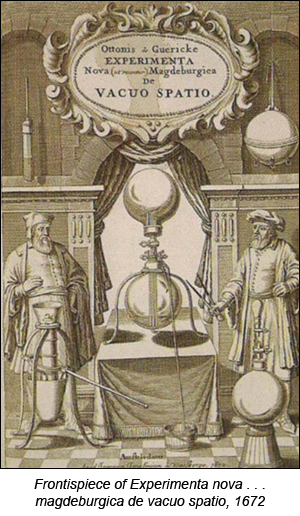 The “experiments” were only temporarily “abandoned.” “They made helicopters out of bamboo, paper, corks and rubber bands and allowed us to run after them when they flew them,” their nephew recalled of his famous uncles many years later.29 After more than five hundred years, the little helicopter toy was alive and well and inspiring a new generation of children with an interest in flight. Its history can be traced on the shelves of the Gimbel collection.
The “experiments” were only temporarily “abandoned.” “They made helicopters out of bamboo, paper, corks and rubber bands and allowed us to run after them when they flew them,” their nephew recalled of his famous uncles many years later.29 After more than five hundred years, the little helicopter toy was alive and well and inspiring a new generation of children with an interest in flight. Its history can be traced on the shelves of the Gimbel collection.
So it was with the kite. The oldest aerodynamic device capable of sustained flight, it was manufactured in many variants by generations of youngsters anxious to feel the tug of the wind on a string. Ultimately, however, no device was of more importance to the invention of the airplane than the kite. It was an invaluable tool enabling a century of experimenters, from Sir George Cayley to the Wright brothers, to investigate wing design, structural forms, and aeronautical control systems without risking their lives in gliding flight.
Unfortunately, the suitability of the kite as a model for a heavier-than-air flying machine was not apparent prior to 1800. For the moment, those who dreamed of heavier- than-air flight continued to focus on the chimera of flapping wings.
Lighter-Than-Air Balloons
Human beings first took to the sky on the basis of a completely different and much simpler principle, one for which nature offered few clues and no obvious examples. Rather, as the shelves of the Gimbel collection demonstrate, the technology of buoyant flight was rooted in the growing interest of seventeenth- and eighteenth- century natural philosophers in the nature of the atmosphere.
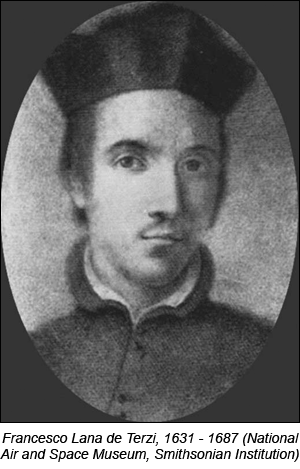 Researchers can examine a very late edition (1672) of Experimenta nova . . . magdeburgica de vacuo spatio in which Otto von Guericke (1602-1686), a city official of Magdeburg, announced his discovery that air, like any other fluid, could be pumped out of a sealed vessel. Fascinated, the English experimenter Robert Boyle (1627-1691) asked his two laboratory assistants (one of whom was Robert Hooke) to design and build a new and improved air pump.
Researchers can examine a very late edition (1672) of Experimenta nova . . . magdeburgica de vacuo spatio in which Otto von Guericke (1602-1686), a city official of Magdeburg, announced his discovery that air, like any other fluid, could be pumped out of a sealed vessel. Fascinated, the English experimenter Robert Boyle (1627-1691) asked his two laboratory assistants (one of whom was Robert Hooke) to design and build a new and improved air pump.
Using the new pump, Boyle (represented in the Gimbel collection by Occasional reflections upon several subjects, 1665) conducted a series of experiments that became the basis for his most important discoveries: a statement of the relationship between temperature, pressure, and volume that would be known as Boyle's law; confirmation of the fact that air pressure explained the operation of Torricelli's mercury barometer; and proof that air was required for the propagation of sound, and for combustion and respiration.
The work of the pneumatic physicists had immediate technological consequences, notably the introduction of the earliest steam pumps by Denis Papin and Thomas Savery during the years 1681 to 1698. The new discoveries also inspired the earliest useful speculations on buoyant flight. Gaspar Schott (1608-1666), whose Magia universalis naturae et artis (1657-1659) had introduced Robert Boyle to the work of Otto von Guericke, was the first thinker to suggest that copper globes filled with ether, a very light substance presumed to fill the empty space of the universe, might rise into the air.
Richard Gimbel was fortunate to obtain five copies of an even more influential volume, Prodromo (1670) by the Jesuit priest Francesco Lana de Terzi. One of those volumes is an especially impressive bibliographic prize, for it once belonged to Gaston Tissandier, the great French balloonist who was the most significant aeronautical collector of the nineteenth century. Published at Brescia in 1670, the thin volume, bound in vellum, contains a proposal for a lighter-than-air flying machine that, while clearly inspired by Schott, went a step further.
Lana de Terzi suggested that if the air were pumped from a large, thin-walled copper sphere, the device might then weigh less than the amount of air it displaced and rise into the sky. Four such globes, each 20 feet in diameter, might be light enough to carry a human being aloft. Theoretically, Lana was on the right track. A hot-air balloon functions because the heat expands the air inside the envelope, so that the balloon weighs less than the amount of fluid it displaces. Unfortunately for Father Lana, it is still not possible to construct globes of any material that are sufficiently large, light, and strong as to become buoyant when evacuated.
Historians of flight have exhibited an unfortunate tendency to dismiss Lana as an impractical dreamer who had little impact on the future. On the contrary, as the shelves of the Gimbel collection demonstrate, Lana's proposal was widely republished, much commented on, and enormously influential. Father Bernardo Zamagna (1735-1820) produced one of the most impressive of those volumes. Published a century after Prodromo, Zamagna's Navis aeria et Elegiarum monobiblos, an epic of the air in Latin hexameters, describes a voyage around the world in Lana's aerial ship.30
In addition to his own speculations on winged flight, Robert Hooke included a discussion of “P. Fran. Lana's way of making a Flying Chariot. . . ,” complete with an illustration, in his Philosophical Collections (1682). Antonio Vanossi offered an extended commentary on the plan in his Placita physica. . . (1724?), while a 1789 issue of European Magazine featured an illustration of the aircraft, identified as “an air-balloon invented in the last century.” The print is a copy of an original first published in 1714. Tiberius Cavallo, a chemical experimenter and the author of The History and Practice of Aerostation (1785), was one of the pioneer historians of the balloon who described Lana's work with great respect.
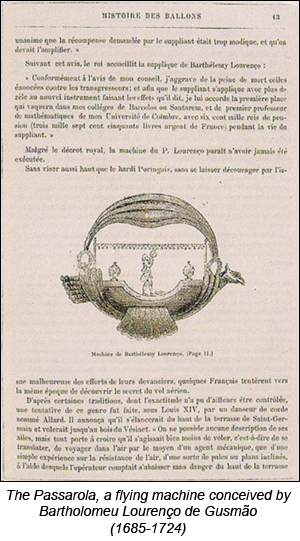 If Gaspar Schott and Father Lana conceived the notion of a lighter-than-air flying machine, a Brazilian priest, Bartholomeu Lourenço de Gusmão (1685-1724) may have been the first to actually build and fly a small balloon. His story begins with a book in the Gimbel collection, Nachricht von dem fliegenden Schiffe, published in Vienna in 1709. The little volume provides what we can safely assume to be a somewhat exaggerated account of Gusmão's aerial voyage from Lisbon to Vienna in 1709 aboard a craft named the Passarola (greatbird). The precise nature of Passarola is not clear in this marvelous fictional account, and accurate information as to what Gusmão actually did achieve is difficult to obtain.
If Gaspar Schott and Father Lana conceived the notion of a lighter-than-air flying machine, a Brazilian priest, Bartholomeu Lourenço de Gusmão (1685-1724) may have been the first to actually build and fly a small balloon. His story begins with a book in the Gimbel collection, Nachricht von dem fliegenden Schiffe, published in Vienna in 1709. The little volume provides what we can safely assume to be a somewhat exaggerated account of Gusmão's aerial voyage from Lisbon to Vienna in 1709 aboard a craft named the Passarola (greatbird). The precise nature of Passarola is not clear in this marvelous fictional account, and accurate information as to what Gusmão actually did achieve is difficult to obtain.
We do know that in 1709 the king of Portugal granted Gusmão a patent for a flying machine called Passarola. There are stories to the effect that Gusmão flew a small fixed-wing glider model that year. Even more convincing, however, are the accounts suggesting that on August 8,1709, Gusmão flew a small balloon in the presence of the king of Portugal at the Salla das Embaixadas in Lisbon. The burning spirits employed to heat the air inside the envelope, or “canopy,” are said to have set fire to the wall hangings and carpets in the room.
Whatever occurred in Lisbon in 1709, news of Gusmão's project spread quickly from one end of Europe to the other. In addition to the anonymous German account, Richard Gimbel acquired a second version of the story in Pierjacopo Martello's Versi, e prose (1710) and a rich assortment of the drawings of Passarola that began appearing across Europe after 1709, often in conjunction with illustrations of Lana's craft.
The illustrations of Passarola show a bird-shaped fuselage, complete with a beaked head and outstretched feathered wings and tail, and a huge, billowing canopy stretched overhead. The various versions of this print have usually been thought to be conjectural illustrations of a large ornithopter, or a fixedwing glider. In view of the very strong evidence in favor of Gusmão's demonstration of a model hot-air balloon, however, it is possible that the print is a depiction of what a full-scale balloon might look like, prepared by an artist who had not actually seen the little craft flown at Lisbon. The canopy could be a misguided attempt to represent what in any case may have been an unconventional envelope.
If Gusmão did fly a small balloon in Lisbon, the world would have to wait three-quarters of a century for the second public flight of a hot-air balloon.The place was the public square of Annonay, a provincial market town and administrative center in the southern French district of the Vivarais. The date was June 4, 1783. Fortunately, the scene was recorded in a contemporary print that is preserved in the Gimbel collection. We see a handful of people, far fewer than were actually there that day. The flight had been timed to coincide with the meetings of the États particuliers of Vivarais, a local legislative and judicial assembly. The town was crowded with officials, visitors with business before the assembly, and local citizens.
Attention is focused on the balloon, trailing tendrils of smoke as it rises slowly into the air. It measured 10 feet in diameter and was constructed of a sandwich of paper and fabric. The material was cut into gores, appropriately shaped strips that could be combined to form a sphere. The print also shows some puzzling nubs running along the edge of the gores. They are the buttons–yes, buttons–that, along with the glue, hold the whole thing together.
This illustration of the first public flight of the brothers Joseph and Étienne Montgolfier has a value quite beyond the information that it communicates about the birth of the air age. It is the rarest aeronautical print in the Gimbel collection and may be the only original copy of this image in the United States.
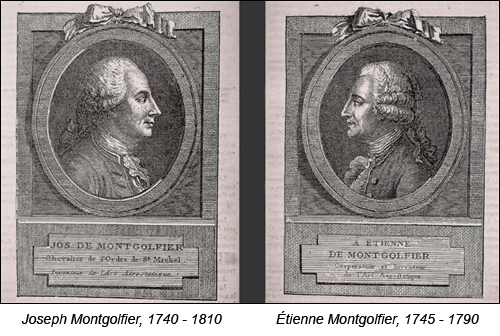 If seventeenth-century studies of pneumatic physics inspired the notion of buoyant flight, the eighteenth- century effort to analyze the constituent gases of the atmosphere led directly to the invention of the balloon. It is a story told in several volumes contained in the Gimbel collection, notably Tiberius Cavallo's The History and Practice of Aerostation (1785). Cavallo, a Neapolitan experimenter living in England, knew the principal chemists involved in analyzing the atmosphere and helped to bridge the gap between the laboratories of the chemists and the workshops of the men who built and flew the first balloons.
If seventeenth-century studies of pneumatic physics inspired the notion of buoyant flight, the eighteenth- century effort to analyze the constituent gases of the atmosphere led directly to the invention of the balloon. It is a story told in several volumes contained in the Gimbel collection, notably Tiberius Cavallo's The History and Practice of Aerostation (1785). Cavallo, a Neapolitan experimenter living in England, knew the principal chemists involved in analyzing the atmosphere and helped to bridge the gap between the laboratories of the chemists and the workshops of the men who built and flew the first balloons.
The first step was taken in 1756 when the Scottish chemist Joseph Black identified the first truly elemental gas, “fixed air,” or nitrogen. A decade later Henry Cavendish announced the discovery of “phlogisticated,” or “inflammable,” air, a gas (from the German geist– “spirit”) that was much lighter than either nitrogen or atmospheric air. The balloon would be seven years old before Antoine-Laurent Lavoisier applied the name hydrogen to the gas discovered by Cavendish.
The discovery of a new gas six times lighter than air inspired several pioneering chemists to explore just how much weight “inflammable air” might lift. Joseph Black considered inflating the bladder of a calf with the gas but did not do so. Tiberius Cavallo actually tried Black’s experiment but could not find a bladder that offered sufficient volume for weight. He did, however, devise an apparatus for blowing hydrogen-filled soap bubbles that rose to the ceiling.
Joseph Montgolfier (1740-1810) was one of many curious Frenchmen who were fascinated by the work of the English pneumatic chemists. The twelfth of sixteen children born to a family that had been involved in the manufacture of paper since the fourteenth century, Joseph was an absent-minded eccentric, quite unlike his younger brother Étienne, the fifteenth child and the best businessman of his generation of Montgolfiers. Yet Joseph was the one who would immortalize the family name.
Following the invention of the balloon, some writers wondered if the Montgolfier brothers had been inspired by Joseph Galien's L’art de naviger dans les airs (1757), published in Avignon, where Joseph had lived for a time. In this fantasy, represented in the Gimbel collection by a copy once owned by Gaston Tissandier, the author follows the line of reasoning pioneered by Gaspar Schott, speculating that an airship filled with ether might be used to escape flood or pestilence.
If Joseph did read the book, he kept that fact to himself. In general terms, he was much more interested in science than in science fiction. Matthieu Duret, a younger physician and Joseph's cousin, remembered that as early as 1777 Joseph had repeatedly quizzed him on the content of the public lectures offered in Paris on the new discoveries in pneumatic chemistry. Matthieu objected when Cousin Joseph suggested that an understanding of pneumatic chemistry might lead to the design of a flying machine. “All that you have taught me of chemistry, only confirms me more fully in my ideas,” he responded. “I must make some experiments.”31
Joseph conducted the most critical of those experiments in November 1782. Convinced that “heat” was a fluid related to the other new “airs” and that the combustion of organic materials would produce a very lightweight “rarified air,” he constructed a frame of very light wood covered with finely woven taffeta and filled it with very hot air. It flew. “Get in a supply of taffeta and cordage, quickly,” he wrote to Jacques-Étienne, “and you will see one of the most astonishing sights in the world.”32
News of the Montgolfier flight on June 4,1783, was slow to reach Paris. The controller general of finance, who received the official report of the États particuliers late in June, was probably the first man in Paris to discover that the age of flight had begun. On July 10, a Paris newspaper published an extract of a very brief account of the flight by a witness. The first relatively full and accurate account did not appear in a Paris newspaper until July 27, 53 days after the flight.
By the time the first detailed article appeared, however, a subscription had already been filled to fund the construction of a balloon to be flown in Paris. The original report from Annonay had been communicated to the savants of the Academy of Science, who were willing to wait for the Montgolfiers to arrive in Paris. Barthélemy Faujas de Saint-Fond (1741-1819), a naturalist at the Musée d'Histoire Naturelle in Paris, was less patient.
As a young man Faujas had abandoned a promising legal career in order to pursue a deep interest in science, earning his reputation with a study of ancient vulcanism in the Vivarais. Sir Joseph Banks, president of the Royal Society, was fond of Faujas but described him as a bumptious fellow, possessed of “effrontery” to “an eminent degree.”33
Certainly, Faujas showed little restraint in the spring of 1783. When he learned of the events in Annonay and realized that the members of the Academy were going to watch and wait, Faujas simply announced that he was selling tickets to a balloon launch and turned the money over to Jacques Alexandre César Charles, the man whom he had selected to construct a balloon.
Charles, one of the best known scientific lecturers in Paris, had given up a budding career as a government administrator after reading Benjamin Franklin's treatise on electricity. The notion of “inflammable air” was very much on his mind. In mid-June Antoine-Laurent Lavoisier had demonstrated for the first time that water was a compound of that very light gas and “dephlogisticated air,” or oxygen, which Joseph Priestley had identified in 1774. It probably did not even occur to Charles that the Montgolfiers had filled their balloon with anything other than hydrogen.
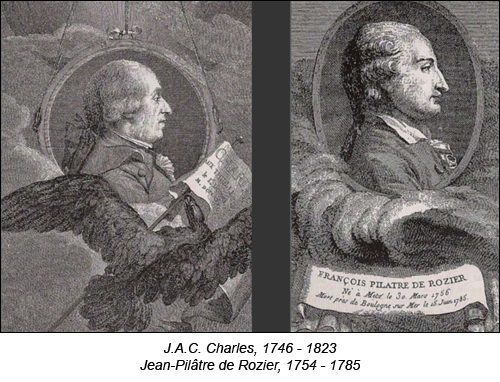 With the assistance of the brothers A. J. and M. N. Robert, who had developed a process for coating fabric with natural rubber, Charles built a demonstration balloon and an apparatus for generating large quantities of hydrogen. An enormous crowd of Parisians gathered near the Champ de Mars, the great parade ground in front of the École militaire on the afternoon of August 27,1783, to witness the first flight of a gas balloon, just as Faujas had promised. “It diminished in Apparent Magnitude as it rose,” Benjamin Franklin reported, “till it entered the Clouds, when it seem'd to me scarce bigger than an Orange.” At the conclusion of the demonstration, Franklin, the leader of the American diplomatic community in Paris, overheard a spectator remark that the balloon was nothing more than a useless toy. “Of what use,” the American responded, “is a new bornbabe?”34
With the assistance of the brothers A. J. and M. N. Robert, who had developed a process for coating fabric with natural rubber, Charles built a demonstration balloon and an apparatus for generating large quantities of hydrogen. An enormous crowd of Parisians gathered near the Champ de Mars, the great parade ground in front of the École militaire on the afternoon of August 27,1783, to witness the first flight of a gas balloon, just as Faujas had promised. “It diminished in Apparent Magnitude as it rose,” Benjamin Franklin reported, “till it entered the Clouds, when it seem'd to me scarce bigger than an Orange.” At the conclusion of the demonstration, Franklin, the leader of the American diplomatic community in Paris, overheard a spectator remark that the balloon was nothing more than a useless toy. “Of what use,” the American responded, “is a new bornbabe?”34
One balloon after another rose above the Paris skyline during the next three months. The royal family was in attendance on September 19, when Étienne Montgolfier sent a sheep, a duck, and a rooster aloft from the palace at Versailles. Pilâtre de Rozier, who lectured on science under the patronage of Comte de Provence, and François Laurent, the Marquis d'Arlandes, the first two human beings to make a free flight, rose from the grounds of the Château de la Muette on November 21 aboard a Montgolfier hot-air balloon. Less than two weeks later, J.A.C. Charles and M.N. Robert became the first human beings to make a flight with a gas balloon. Less than a year after the first flight of a small balloon from Annonay, the air age was well under way.
The shelves of the Gimbel collection contain a wealth of materials that enables us to reach back more than two centuries and recapture some sense of the incredible excitement occasioned by the invention of the balloon. Here are manuscript letters from the Montgolfiers and their relatives, Pilâtre de Rozier, and other participants, commenting on everything from the cost of hats and difficulties of travel to the details of the first balloon ascents.
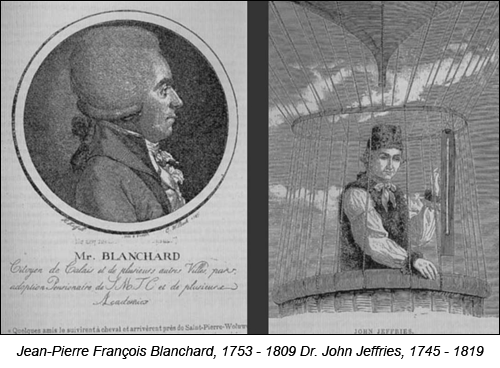 Pamphlets and articles by the Montgolfiers, J.A.C. Charles, the Robert brothers, Pilâtre de Rozier, and the Marquis d'Arlandes grace the Gimbel shelves. Other first-generation aeronauts represented in the Gimbel collection include Paolo Andreani, who made the first flight outside of France; Jean-Pierre François Blanchard, the first of the great professional aeronauts; Dr. John Jeffries, the first American to make a free flight, and the man who accompanied Blanchard on the first flight across the English Channel; and André Jacques Garnerin, who earned his early reputation by making parachute jumps from balloons.
Pamphlets and articles by the Montgolfiers, J.A.C. Charles, the Robert brothers, Pilâtre de Rozier, and the Marquis d'Arlandes grace the Gimbel shelves. Other first-generation aeronauts represented in the Gimbel collection include Paolo Andreani, who made the first flight outside of France; Jean-Pierre François Blanchard, the first of the great professional aeronauts; Dr. John Jeffries, the first American to make a free flight, and the man who accompanied Blanchard on the first flight across the English Channel; and André Jacques Garnerin, who earned his early reputation by making parachute jumps from balloons.
It was the irrepressible Barthélemy Faujas de Saint-Fond, however, who quickly emerged as the most significant historian of the birth of flight. Angry at the false and misleading accounts that were rushed into print in the immediate aftermath of a flight, Faujas set out to produce an extended, detailed, and accurate account of the events that he had witnessed and helped to shape. His first book on the subject, the two-volume Description des expériences de la machine aérostatique . . . , was published so quickly that it was dated 1783-1784. The Gimbel collection holds Dutch, Belgian, German, English, and Italian editions of the work, all published before the end of 1784.
In addition to letters, newspapers, pamphlets, and books, the citizens of the late eighteenth century relied on inexpensive and widely distributed printed images to help them visualize the distant places, people, and events of their day. The creation, production, distribution, and sale of such single-sheet images was a minor industry prior to the rise of illustrated newspapers and magazines in the nineteenth century. The invention of the balloon inspired an outpouring of prints unmatched by any other event in the late eighteenth century.
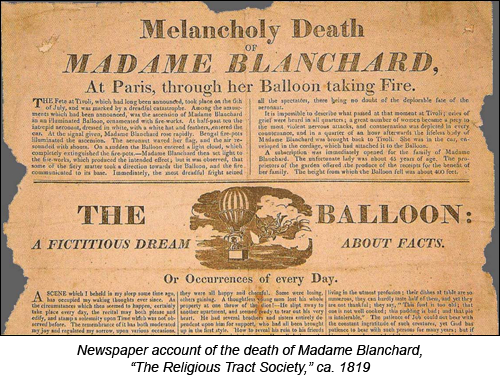 The Gimbel collection contains multiple prints illustrating each of the great Paris ascents of 1783. At least a dozen different views of the first flight of human beings on November 21, 1783, were on sale in the shops and stalls of Europe before the end of 1785. Richard Gimbel acquired two illustrations of that flight as seen from the terrace of Benjamin Franklin's home, the Hôtel de Valentinois, in the Paris suburb of Passy. In addition to the eighteenth-century prints, Richard Gimbel collected a number of more recent artistic interpretations of the moment when human beings first took to the sky, including a misty and evocative painting on wood and a print by Marcel JeanJean, a World War I aviator and official painter to the French minister of air.
The Gimbel collection contains multiple prints illustrating each of the great Paris ascents of 1783. At least a dozen different views of the first flight of human beings on November 21, 1783, were on sale in the shops and stalls of Europe before the end of 1785. Richard Gimbel acquired two illustrations of that flight as seen from the terrace of Benjamin Franklin's home, the Hôtel de Valentinois, in the Paris suburb of Passy. In addition to the eighteenth-century prints, Richard Gimbel collected a number of more recent artistic interpretations of the moment when human beings first took to the sky, including a misty and evocative painting on wood and a print by Marcel JeanJean, a World War I aviator and official painter to the French minister of air.
The tradition of commemorating the great events in the history of flight with fine examples of numismatic art began in 1783, when the Paris Mint issued a lovely medal honoring the Montgolfier brothers, “POUR AVOIR RENDU L’AIR NAVIGABLE.” The Mint issued another medal the following year commemorating the first flights of human beings aboard the Montgolfier and Charles balloons. Gimbel obtained examples of both medals restruck using the original dies, as well as a variety of additional numismatic items celebrating the achievements of the great aeronauts of the nineteenth century from the time of Vincent Lunardi, who made the first hydrogen balloon flight in England in 1784, to Charles Green, the most experienced and famous of the Victorian aeronauts, and his American contemporary Thaddeus Sobieski Constantine Lowe, who earned fame as the leader of the Union army balloon corps during the Civil War.
The Uses of a Newborn Babe
The Gimbel collection is a treasure trove of materials tracing the history of ballooning through the end of the nineteenth century. The sheer number of prints and published accounts documents the wave of interest in flight that swept across Europe following the annus mirabilis of 1783. The new invention had shattered the chains of gravity and offered the promise of conquering the old barriers of time and space. People expressed this sense of new possibility in very personal terms. “If it were possible to have one of the new aerial carriages,” a French nun remarked to her brother in a letter surviving in the Gimbel collection, “I could travel through the air . . . to tell you what my heart would . . . say and would return from that content to savor the happiness of my solitude.”35
As the large number of satirical prints in the collection demonstrates, however, the invention of the balloon also inspired considerable cynicism. Some prints, including “The Aerostatic Man or My Poor Uncle” and “The Definitive Judgment in Favor of Srs. Miolan and Janinet,” seem calculated to puncture the scientific pretensions and pomposity affected by aeronauts of the period. Others, like “The New Mode of Picking Pockets” and “Aerostation out at Elbows,” raised questions as to the basic utility of the new technology. In spite of Franklin's bon mot, there remained a great deal of doubt as to the “use of a newborn babe.”
During the nineteenth century, many aeronauts in Europe and America earned their living by performing feats of aerial derring-do high above a crowd of paying spectators and by capturing newspaper headlines with spectacular long-distance flights. The names of those who made aeronautical history are preserved on the posters, tickets, news clippings, letters, and books of the Gimbel collection: Jeanne-Geneviève Garnerin, the first woman pilot-in-command; Louis Charles Guillé, who introduced parachute jumping in the United States; Marie Madeleine Sophie Blanchard, the second wife of J.-P.F. Blanchard and the first woman to die in a ballooning accident; and George and Margaret Graham, the husband and wife aeronauts who thrilled crowds in Victoria's England.
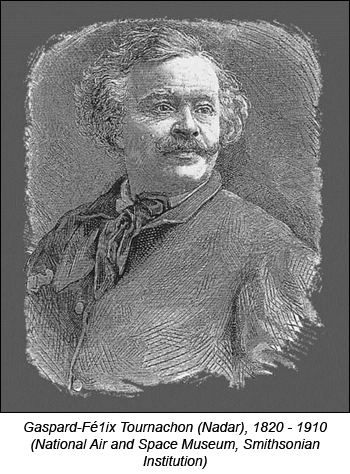 Some aspects of nineteenth-century aerial showmanship apparent in the Gimbel collection may surprise modern readers. Consider, for example, a print showing a series of large inflated animals soaring over the Paris skyline. It is a reminder that the delightful helium-filled comic figures associated with American holiday parades are simply the latest versions of the hydrogen-filled fabric creations produced for public celebrations in Europe and America during the late eighteenth and early nineteenth centuries.
Some aspects of nineteenth-century aerial showmanship apparent in the Gimbel collection may surprise modern readers. Consider, for example, a print showing a series of large inflated animals soaring over the Paris skyline. It is a reminder that the delightful helium-filled comic figures associated with American holiday parades are simply the latest versions of the hydrogen-filled fabric creations produced for public celebrations in Europe and America during the late eighteenth and early nineteenth centuries.
Those who delight in hangar flying tales of aerial adventure will enjoy discovering the stories of the great balloons, aeronauts, and long-distance flights of the nineteenth century preserved in the Gimbel collection. Take the case of Gaspard-Félix Tournachon's great balloon, Le Géant. Tournachon, a pioneering French photographer who worked under the professional name of Nadar, became fascinated by aeronautics in the 1850s. Along with the American Samuel Archer King, he was one of the first practitioners of aerial photography. He unveiled his huge balloon, Le Géant, in the fall of 1863. It stood 196 feet tall, could lift 4.5 tons of useful load, and featured a two-story, six-room, wicker-work gondola complete with four berths, a lavatory, a darkroom for developing aerial photographs, and a printing press.
Le Géant carried fifteen people, including the “young and personable” Princess de la Tour d'Auvergne, on its first flight. The great adventure ended only about 30 miles from the take-off point with the bungalow of the gondola being dragged for a mile across the landscape while the passengers hung on for dear life. Between 1863 and 1867, Nadar made a series of celebrated ascents, including one long-distance flight into Germany. The adventurous details of the various flights were published in illustrated newspapers on both sides of the Atlantic.
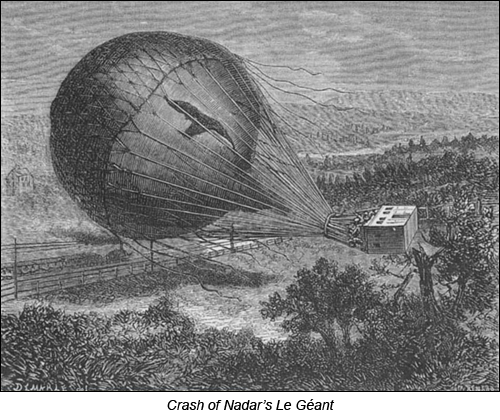 As the Gimbel collection attests, Nadar and his enormous balloon inspired everything from advertisements to children's board games. Many published accounts of the adventures of this real life Jules Verne hero are to be found on the Gimbel shelves. Nadar himself wrote the preface for one of the best: Alfred Sircos and Th. Pallier, Histoire des ballons et des ascensions célèbres (1876).
As the Gimbel collection attests, Nadar and his enormous balloon inspired everything from advertisements to children's board games. Many published accounts of the adventures of this real life Jules Verne hero are to be found on the Gimbel shelves. Nadar himself wrote the preface for one of the best: Alfred Sircos and Th. Pallier, Histoire des ballons et des ascensions célèbres (1876).
The dream of very long distance flights, however, was born and nurtured in America. The notion of flying the Atlantic can be seen in a variety of materials preserved by Richard Gimbel, including accounts of transoceanic dreamers like John Wise and Washington Harrison Donaldson, both of whom disappeared during the course of long-distance flights over the Great Lakes. Wise published A Systern of Aeronautics (1850), his history and guide to ballooning, close to the outset of his career, and his fully developed autobiography, Through the Air (1873), more than a quarter of a century later. Both volumes remain as classics of the literature of flight. M. L. Amick's History of Donaldson's Balloon Ascensions (1875) offers a classic, and comical, account of the career of one of the most colorful aeronauts of the nineteenth century, complete with a series of lively and delightful primitive woodcut illustrations.
Materials related to the two most famous American newspaper hoaxes of the nineteenth century are also preserved on these shelves. Edgar Allan Poe perpetrated the “balloon hoax” with the best of motives. In order to feed himself and his invalid wife, he wrote the false account of Thomas Monck Mason's supposed aerial crossing of the Atlantic. The other hoax–the “moon hoax”–we will come to in due time.
The Gimbel collection includes a wealth of additional materials documenting the ultimate dream of an Atlantic crossing, including a letter describing Richard Clayton's 1835 record-setting 350-mile flight from Cincinnati to Monroe County, Virginia; a published account of the 1859 flight of the balloon Atlantic, piloted by John Wise, John LaMountain, and two companions, 809 miles from St. Louis to Henderson County, NewYork; and a rare medal struck in 1859 and sold to raise funds for T.S.C. Lowe's effort to fly the Atlantic in the City of New York.
Having failed to raise the funds to fly from New York, Lowe relocated the project to Philadelphia and renamed his giant balloon the Great Western, a comment on the huge steamship Great Eastern, designed and built by the English engineer I. K. Brunel. The project collapsed when the citizens of the City of Brotherly Love proved no more enthusiastic about the huge balloon than their New York cousins. In addition to the medal commemorating the City of New York, Richard Gimbel acquired a marvelous comic print comparing the balloon and Brunel's leviathan steamship, which was also the butt of a great many jokes.
Throughout the nineteenth century, however, there were those who believed that the balloon ought to be put to some more worthy purpose than that of a vehicle for adventurers or as a centerpiece around which to organize public spectacles. A recognition that the ability to fly would have revolutionary military applications dated at least to Francesco Lana de Terzi, who believed that for all of his own plans, God would never permit human beings to fly. The prospect of an attack from the sky on defenseless civilians was too terrible to contemplate.
The Gimbel print files contain several images of L’Entreprenant, the world's first military aircraft. Constructed by Charles Coutelle and N. J. Conte, who had organized a Corps d'Aérostiers for the Army of Revolutionary France, the observation balloon first saw service at the Maubeuge and Fleurus in 1794. Additional popular prints illustrate the use of the observation balloon in the American Civil War and the Spanish- American War. Interested researchers will also find a copy of Thaddeus S.C. Lowe's written report of his service with the Army of the Potomac preserved in the Gimbel collection, along with photographs of his balloons and equipment.
One of the most interesting Gimbel items relating to military aeronautics is a long Chinese scroll illustrating the various stages in the deployment of an observation balloon. The scroll probably documents the scene at the Tientsin Military Academy in 1887, when French contractors, including the aeronaut Pillas-Panis, instructed students in the management of the equipment required to maintain and operate an observation balloon in the field. Gimbel, an experienced military airman, amassed personal accounts, official reports, illustrations, and historical studies detailing the full range of experiments undertaken in military aeronautics prior to 1914.
In bibliographic terms, however, there can be no doubt that the wealth of materials relating to aeronautics in the Franco-Prussian War constitutes a unique strength of the Gimbel collection. Seldom has a nation entered a conflict with more enthusiasm, or collapsed as quickly, as did the France of Louis Napoleon. Thousands of French troops had marched out of Paris in July 1870, clad in colorful uniforms beneath waving flags, the cry of “on to Berlin” ringing in their ears. By September 20, the Emperor had surrendered at Sedan and the first of General Moltke's 150,000 gray-clad troops were knocking on the gates of Paris.
Although both nations had given some thought to aerial warfare, observation ballooning did not play an important role in the early phases of the conflict. Henry Tracey Coxwell, the famous English balloonist, working as a contractor, had provided the Prussian army with two balloons and the equipment, except for gas generators, required to maintain them in the field. He had also trained two companies of twenty men each to move and operate the balloons. Without a means of inflation on the march, however, the single balloon that accompanied the invading army was worthless. The entire unit was ordered back to Germany. Coxwell's memoir of this effort, My Life and Balloon Experiences, with a Supplementary Chapter on Military Ballooning (1887), offers a rare account of aeronautics on the Prussian side of the lines.
Marshal Leboeuf, the French minister of war, had opposed the use of balloons, so that it was not until after the surrender at Sedan and the death of the Second Empire that Nadar, the colorful photographer and aeronaut, made a tethered ascent inside the city to observe the movement of besieging German troops. M. Rampont, the minister of posts, then announced the creation of a balloon post that would carry mail out of the city over the heads of the besieging Germans. There would be two classes of balloon mail: “monté ” and “non-monté.” Letters monté, prepared on small sheets of lightweight paper weighing less than 4 grams, would be carried aboard manned balloons. Non-monté communications would be written on special postcards and sent aloft aboard unmanned balloons in the hope that they would come down inside French lines and be forwarded to the addressee.
When the siege began, there were seven balloons in Paris. At the rate of a flight or two a week, the supply was soon exhausted. Nadar, Eugène Godard (a veteran of 800 ascents), and other experienced aeronauts organized 60 seamstresses and transformed the city's great railroad stations, where the trains no longer ran, into balloon factories. The supply of experienced aeronauts was also limited. Before the siege was over, 18 trained balloonists, 17 volunteers, and 30 sailors who were trapped in the city would pilot balloons out of Paris.
Some 58 of the more than 65 balloons launched from Paris during the siege (September 1870–January 1871) reached safety, They carried 2,500,000 pieces of mail and 102 passengers, including Leon Gambetta, a government official who was wounded by a Prussian bullet and barely escaped capture. Fearful of coming down within German lines, one team of aeronauts flew about 520 miles to a landing in Longsburg, Norway, 14 hours, 40 minutes after takeoff. Another balloonist flew 285 miles in fewer than 3 hours, averaging 95 miles per hour!
Of course, getting mail and personnel out of the city was only half of the problem. Several methods of getting messages into Paris were considered and rejected– including the use of dogs and the notion of floating objects down the Seine. Ultimately, ingenious postal officials decided to combine carrier pigeons with advanced technology.
The first step was for M. Dagron, a specialist in microphotography, to leave the city aboard the balloon Niepce. Reaching the wartime capital of Tours, he established a photographic facility and began producing microfilm copies of government dispatches and letters intended for Paris. Eventually, as many as 40,000 pages could be carried by a single bird. The homing pigeons were flown out of Paris aboard the balloons, loaded with messages, and released to fly back to the city. Once retrieved, the film was processed and the messages projected onto a wall, copied by stenographers and distributed. The people of Paris were reduced to eating rats during the siege, but their mail arrived on time.
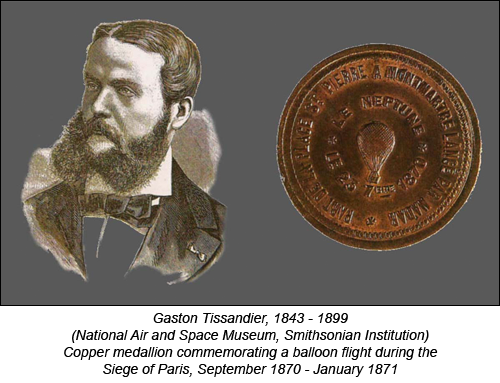 Memories of the disastrous war with Prussia would shape French policy for seven decades. Patriots could take pride in the role that the aeronauts of Paris had played during the siege, however. Autobiographical accounts of the leading aeronauts of the siege, like Gaston Tissandier's En Ballon! (1871), as well as the descriptive volumes and histories of the balloons and the pigeon post, sold well during the years following the conflict.
Memories of the disastrous war with Prussia would shape French policy for seven decades. Patriots could take pride in the role that the aeronauts of Paris had played during the siege, however. Autobiographical accounts of the leading aeronauts of the siege, like Gaston Tissandier's En Ballon! (1871), as well as the descriptive volumes and histories of the balloons and the pigeon post, sold well during the years following the conflict.
In addition to holding published accounts unmatched by any other American library, the Gimbel collection contains a treasure trove of other materials describing the role of aeronautics in the Franco-Prussian War. The collection includes a rich assortment of the newspapers published in the city during the siege based on information supplied by the pigeon post: Lettre-Journal de Paris, Dépêche-Ballon, La Cloche Journal-Poste and L’Indépendant. Researchers will also find thirty examples of letters delivered “par ballon monté” and a pair of microprints.
The Gimbel siege collection also contains printed images, notably “Au Bastion,” a lithograph illustrating a lovely Parisienne standing atop a city bastion with a balloon passing overhead. One of Richard Gimbel's most interesting numismatic acquisitions is a small jeton or token, celebrating the pigeon post. During the course of the siege, Paris entrepreneurs produced for sale a total of 83 distinct copper or lead medallions of this sort commemorating the escape of one or another of the balloons from the city. Moreover, the provisional government of Paris authorized proof sets of coins featuring the balloons. The coins themselves were not issued after the siege.
The jeton, along with the wealth of other materials in the Gimbel collection relating to aeronautics in the Siege of Paris, represents a priceless scholarly resource enabling researchers to examine a critically important moment in the early history of military aviation from a number of points of view.
Navigating the Air
The balloon had opened the skies to human beings, but it remained a captive of the winds. Numerous materials documenting the evolution of designs for a dirigible balloon, a powered airship capable of navigating the air, are found in the Gimbel collection. Prints illustrate the early airship designs of Louis Charles Guillé, Muzio Muzzi, Carmien de Luze, Ernest Pétin, and Russell Thayer. A wonderfully optimistic handbill dated 1835 announces the imminent departure of the airship Eagle on a round-trip flight from Kensington, England to Paris with 17 passengers on board.
Rufus Porter, the founder of Scientific American, established the Aerial Navigation Company in 1852. Intended to develop a passenger carrying airship, the project is memorialized in a stock certificate, complete with an illustration of the cigar-shaped Aeroport, which is preserved in the Gimbel collection.
Solomon Andrews, the mayor of Perth Amboy, New Jersey, during the Civil War, went a step further than his predecessors, commissioning the Pennsylvania balloonist John Wise to construct a one-man version of the Aereon airship, some 60 feet long. Andrews' craft did fly and generated some public enthusiasm. Ultimately, however, he was pursuinging a will-o’-the-wisp, seeking to employ the power of the air flowing around the descending airship to both propel and control the motion of the craft. It was an aeronautical version of perpetual motion. The details of the story are fully recorded in Richard Gimbel's copy of Solomon Andrews' 1865 publication The Art of Flying.
French engineer Henri Giffard took the first serious step toward the navigation of the air in 1852, when he guided his steam-powered airship through the first circle in the air. A contemporary print in the Gimbel collection shows the Giffard craft with an enclosed gondola rather than the open platform on which the intrepid aeronaut, clad in a frock coat and top hat, actually stood. The subsequent experiments of Gaston Tissandier, Paul Haenlein, Charles Renard and Arthur Krebs, and Karl Woelfert are detailed in a series of volumes found on the Gimbel shelves.
Alberto Santos-Dumont's autobiographical account, My Air-Ships, remains a particular favorite. The son of one of the wealthiest coffee planters in Brazil, Le Petit Santos had come to Paris to study engineering and became fascinated by the subject of flight. He burst onto the public scene in 1901, when he won the rich prize offered by Henri Deutsch de la Meurthe for the first flight from the Aéro-Club field at St. Cloud to the Eiffel Tower and back. Thousands of Parisians turned out to watch and to cheer their new hero on to victory. In one of those grand gestures so typical of him, the young Brazilian divided the prize money among the members of his ground crew.
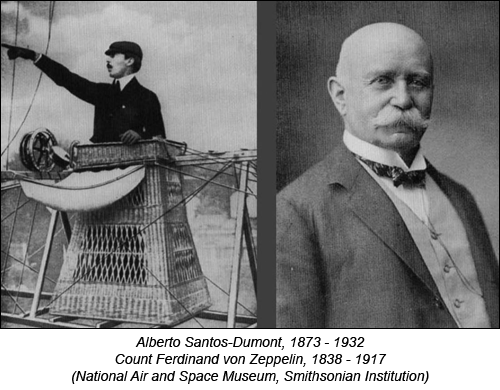 The sight of Santos-Dumont cruising above the rooftops of the city in a one-man airship powered by an internal combustion engine delighted residents of the City of Light. All of Paris knew that Santos carried his obsession with flight to such an extraordinary degree that he dined at a table and chairs suspended from the ceiling of his apartment. The story of the day on which he landed on a boulevard, tethered his craft, and enjoyed an apéritif in a sidewalk cafe became a legend of the city.
The sight of Santos-Dumont cruising above the rooftops of the city in a one-man airship powered by an internal combustion engine delighted residents of the City of Light. All of Paris knew that Santos carried his obsession with flight to such an extraordinary degree that he dined at a table and chairs suspended from the ceiling of his apartment. The story of the day on which he landed on a boulevard, tethered his craft, and enjoyed an apéritif in a sidewalk cafe became a legend of the city.
But the efforts of Santos-Dumont and other early twentieth-century aeronauts who operated one-man airships were overshadowed by the achievements of Count Ferdinand von Zeppelin. The Count organized his first joint stock company in 1894; flew his first rigid airship in 1900; achieved practical success with the LZ6 in 1906; and, by 1913, was regularly carrying passengers on excursion flights over German cities. A symbol of German national pride and technological achievement, the giant rigid airships were universally recognized as the first practical strategic weapons system.
The Gimbel collection includes prints (like “Zeppelin über den Bodensee” and a child's cut-out paper model of a “dirigible militaire”) that speak volumes. The frail airplanes of the period scarcely seemed to offer much of a threat, but the image of a German airship cruising high over a defenseless city provided the people of London and Paris with food for thought. Three centuries before, Francesco Lana de Terzi had predicted that this day would come. The power to fly had carried the world to the doorstep of total war.
Wings
The age-old dream of winged flight was also realized during the first decade of the new century. The Gimbel collection traces the notion of flying like a bird from the legends represented on the Mesopotamian seals, through the era of Leonardo da Vinci, to the development of the earliest aerodynamic devices such as kites and helicopter toys. The fact remains that Sir George Cayley (1773-1857), an English baronet with an estate at Brompton Hall in Yorkshire, took the first serious steps toward the realization of the dream.
One of the genuine rarities preserved in the Gimbel collection is a thin, 56-page German pamphlet titled Dresdener Chroniken, und Geschichts, Calender 1809, containing an illustration of a brave soul wearing a pair of trussed, ornithopter wings developed by a Swiss clock-maker named Jacob Degen. Reports that Degen had actually gotten his machine off the ground circulated widely between 1807 and 18l7. What this illustration does not show, and what most other accounts of the project failed to mention, was that Degen had tested his machine dangling beneath a large balloon, without which it would not have risen an inch into the air.
The Degen hoax had one great consequence. It convinced George Cayley to publicize his own aeronautical experiments. By 1809, when he first heard that Degen had flown, Cayley had already conducted a series of experiments to gather data that could be used in designing a flying machine; developed the modern conception of an airplane as a craft with separate systems for lift, propulsion, and control; and built and flown a full-scale but unmanned glider, the first in the world of which we can be certain. At work for over a decade, he had decided not to publish the results of his studies–until the article on Degen convinced him that if he did not publicize his own thoughts and information he would be by-passed and forgotten.
The Gimbel collection does not contain any more influential volumes than the November 1809 and February and March 1810 issues of Nicholson's Journal of Natural Philosophy, Chemistry, and the Arts in which Sir George Cayley published his three-part paper “On Aerial Navigation.” Along with a handful of eighteenth- century studies of windmills, waterwheels, and ballistics, this paper is the foundation stone of aeronautical engineering.
Cayley launched a new era in which the enormous power of engineering research would be brought to bear on the flying machine problem. The most influential nineteenth-century aircraft designs also reflected Cayley's influence, And none was more influential than the Aerial Steam Carriage of John Stringfellow and William Samuel Henson, an illustration of which is preserved in the Gimbel collection.
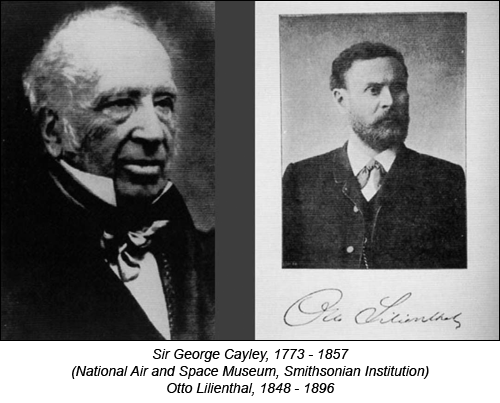 Much of what is important with regard to the history of aerodynamic research in the nineteenth century is contained in the twenty-three volumes of Reports published by the Aeronautical Society of Great Britain, 1866-1893, and preserved in the Gimbel collection. The best of these papers represent milestones in the history of flight, marking the path of technological progress from the age of Cayley through the invention of the wind tunnel (which Francis Herbert Wenham reported in these pages), to the experiments with power plants, models, and gliders that prepared the way for the final steps toward the invention of a successful airplane.
Much of what is important with regard to the history of aerodynamic research in the nineteenth century is contained in the twenty-three volumes of Reports published by the Aeronautical Society of Great Britain, 1866-1893, and preserved in the Gimbel collection. The best of these papers represent milestones in the history of flight, marking the path of technological progress from the age of Cayley through the invention of the wind tunnel (which Francis Herbert Wenham reported in these pages), to the experiments with power plants, models, and gliders that prepared the way for the final steps toward the invention of a successful airplane.
The great aeronautical pioneers who dominated the second half of the nineteenth century–Hiram Maxim, Samuel Pierpont Langley, Clément Ader, Louis Mouillard, Lawrence Hargrave, and others–describe their own work in volumes found on the Gimbel shelves. Here researchers will find a copy of the single most important aeronautical book published between Sir George Cayley's triple paper of 1809-1810 and the turn of the century– Otto Lilienthal's classic Der Vogelflug als Grundlage der Fliegekunst. . . (1889). Having published the engineering data resulting from his meticulous research, Lilienthal turned his attention to the design and construction of gliders. Between 1890 and his death in 1896, as a result of injuries suffered in a glider crash, Lilienthal completed about 2,000 glides in at least 18 distinct glider types.
Octave Chanute (1832-1910), a leading American civil engineer and an international authority on aeronautics, was Otto Lilienthal's chief American correspondent and the link between the German pioneer and the brothers Wilbur and Orville Wright. Chanute's classic, Progress in Flying Machines (1894), summarized a century of research into flight science and technology. His correspondence with the Wright brothers, published in The Papers of Wilbur and Orville Wright (1953), helps us to understand the way in which the two men from Dayton, Ohio, solved the final problems barring the way to success and launched the world into the age of wings.36
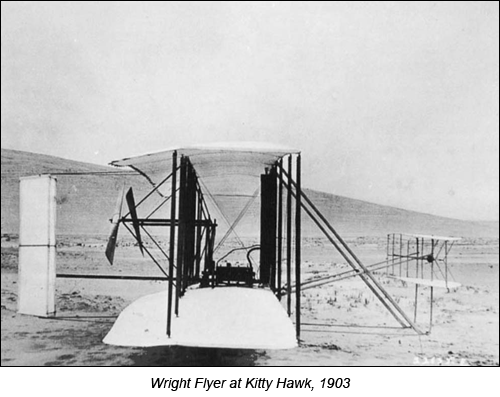 One of Colonel Gimbel’s rarest acquisitions relating to the Wrights is a copy of a monthly journal with the unlikely title Gleanings in Bee Culture. The editor, Amos Ives Root, the proprietor of a Medina, Ohio, apiary supply house, was fascinated by technology. In the fall of 1904, hearing rumors of strange goings-on in a cow pasture 8 miles east of Dayton, Root drove his automobile to the place, where he met Wilbur and Orville Wright and witnessed the first complete circle flown by an airplane. Returning home, he wrote an account that treated the beekeepers of America to the very first eyewitness account of a Wright airplane in the air. The great newspapers of the world had been scooped by an unlikely competitor.37
One of Colonel Gimbel’s rarest acquisitions relating to the Wrights is a copy of a monthly journal with the unlikely title Gleanings in Bee Culture. The editor, Amos Ives Root, the proprietor of a Medina, Ohio, apiary supply house, was fascinated by technology. In the fall of 1904, hearing rumors of strange goings-on in a cow pasture 8 miles east of Dayton, Root drove his automobile to the place, where he met Wilbur and Orville Wright and witnessed the first complete circle flown by an airplane. Returning home, he wrote an account that treated the beekeepers of America to the very first eyewitness account of a Wright airplane in the air. The great newspapers of the world had been scooped by an unlikely competitor.37
The Wrights were the first great heroes of the twentieth century and symbolic figures of enormous importance. Some notion of the enormous range of attitudes toward the brothers and the meaning of their achievement is to be found in two cartoon portraits of Wilbur Wright preserved in the Gimbel collection. In one, a hugely smiling Wilbur, pipe clenched in his teeth, takes a clinging, corpulent, and obviously adoring Marianne, the symbol of the French nation, for a ride in his airplane.
The other image, a caricature on the cover of the French comic journal Le Rire, is a caustic portrait of a mechanistic Wilbur, complete with bolted metal bars for arms and legs, a bellows for a body and bat wings. A scowling grimace spreads across his face, and vultures perch on his wings and cap. One can only wonder what solid, upright Wilbur Wright thought of these two images that were anything but flattering. The son of a bishop of the Church of the United Brethren in Christ–and a man who seems never to have touched tobacco, liquor, or women–Wilbur would have been appalled and offended by the two very different caricatures that indicate the failure of the world's press to understand the two brilliant Americans or their achievement.38
The excitement and energy of the early years of powered, heavier-than-air flight are clearly expressed in the wide range of paper ephemera in the Gimbel collection. Produced by showmen who never dreamed that these items would survive once they had performed the function for which they were intended, the advertisements, tickets, posters, and similar objects remain as colorful and evocative reminders of a bygone time when the sight of an airplane in the sky caused people to stop and stare. They bring the past to life.
A postcard shows a Wright Model A aircraft cruising high over lower Manhattan beneath a slogan suggesting, “High Flyers From Coast to Coast Use Lash's Bitters, The Great Tonic Laxative.” Other items remind us of the great aeronautical events of the era: The tickets to the first and greatest of all the prewar air meets, sponsored by the Champagne producers on the Plains of Betheny, near Reims, are shaped like champagne corks. The price of admission to the International Aviation Tournament at Belmont Park, New York, October 26-30, 1910, was $1, as indicated on each of the four tickets surviving in the Gimbel files. There is a lovely crimson and white program for the 1910 Harvard-Boston Meet, along with an invitation to attend a special educational demonstration by the English aviator Claude Grahame- White during the course of the event.
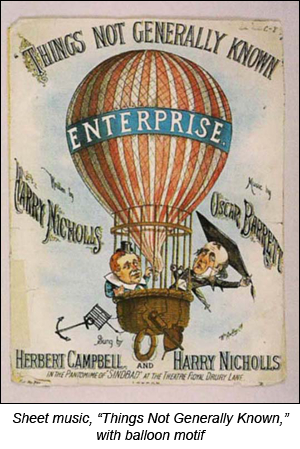 A handbill invites members of the Aero Club of Great Britain and Ireland to meet Louis Blériot, the hero of the first flight across the English Channel. More than any other aeronautical event between the emergence of the Wright brothers and the sound of guns in August 1914, Blériot's achievement shocked the English nation. “It has been raining warnings on us,” H. G. Wells noted. “Never was a slacking, dull people so liberally served with warnings of what was in store for them. . . . In spite of our fleet, this is no longer, from the military point of view, an inaccessible island.”39
A handbill invites members of the Aero Club of Great Britain and Ireland to meet Louis Blériot, the hero of the first flight across the English Channel. More than any other aeronautical event between the emergence of the Wright brothers and the sound of guns in August 1914, Blériot's achievement shocked the English nation. “It has been raining warnings on us,” H. G. Wells noted. “Never was a slacking, dull people so liberally served with warnings of what was in store for them. . . . In spite of our fleet, this is no longer, from the military point of view, an inaccessible island.”39
The number of songs published on aeronautical themes during the first decade of the new century is an indication of the public's fascination with the subject. The Gimbel collection of song sheets includes “Up in My Flying Machine,” a tune dedicated to Dick Ferris, the impresario of the great Dominguez Field Air Meet in Los Angeles, January 10-20, 1910; “Aeroplane, or Flying Machine,” a British song sheet illustrated with a photo of S. F. Cody's biplane; “A Hundred Years from Now,” Tin Pan Alley's vision of a future in which the sky would be filled with airplanes. “Come Josephine in My Flying Machine” is one of the few aeronautical songs in the collection that most people can still hum.
Less than a decade after the first flight of the Wright brothers at Kitty Hawk, the airplane was already performing useful work. One of the treasures of the Gimbel collection is a small postcard that pilot Henri Pequet carried aboard a Sommer biplane at Allahabad, India, in February 1911 as part of the United Provinces Industrial and Agricultural Exhibition. The flight, which covered only 5 miles, nevertheless qualifies as the world's first official airmail flight by airplane. A second postcard in the collection was flown between London and Windsor, September 11, 1911, in celebration of the coronation of King George V.40
Junior Birdmen
The early twentieth-century fascination with flight was by no means limited to adults. Since the middle of the nineteenth century, the authors and publishers of children's books had drawn on aeronautical themes in order to capture the attention of young readers. Books of educational toys and games had long been popular in America. E. Landells’ The Boy's Own Toy-Maker (1859), was typical, offering plans and instructions for a variety of kites and small fire balloons. It remained for the founder of mass market children's publishing in America, however, to take full and shrewd advantage of youthful enthusiasm for flight.
Samuel Griswold Goodrich is a name with which many researchers in the Gimbel collection would not be familiar. He is one of the genuinely forgotten men of American history. In spite of that, he was responsible for a series of important juvenile titles surviving in the Gimbel stacks. A Massachusetts legislator and U.S. consul to Paris, Goodrich may have sold more books than any other publisher in nineteenth-century America. Between the time of his entry into the business in 1816 and his death in 1860, the companies under his control had published as many as 7 million volumes. In addition, Goodrich operated several long-running children's magazines.
Goodrich set the pattern that would prevail in children's publishing for the next century. He issued books in series, bearing the names of fictitious “writers,” notably Peter Parley and Robert Merry, who became wildly popular and attracted an enormous audience of young readers who would want to devour book after book bearing the familiar name. In fact, Goodrich hired a stable of writers, including Nathaniel Hawthorne, to churn out literary product.
Goodrich had given as much thought to the subject matter of his books as to every other aspect of his business. Balloons appear time after time in his series, and The Balloon Travels of Robert Merry . . . may have been the most popular of all the Goodrich titles. The appeal of the theme is not difficult to understand. A balloon voyage offered a sense of ultimate adventure to young readers, as Jules Verne and other writers would discover.
The popularity of flight themes with young readers was a lesson that later publishers were quick to learn. If S. G. Goodrich was the king of children's publishing during the first half of the nineteenth century, the brothers Erasmus and Irwin Beadle launched a whole new era in 1859 when they formed a partnership with Robert Adams. Beadle and Adams gave birth to what would become known as the “dime novel,” a piece of cheap and thrilling fiction printed on even cheaper paper, just in time to meet the cultural needs of Civil War soldiers. The addition of a lurid cover, usually underscoring the moment of maximum danger to the hero, completed the pattern for a “literary” genre that would survive into the new century.41
Richard Gimbel was born a bit too late for the heyday of the dime novel, but he was clearly a connoisseur of those with aeronautical themes. Most of these books, from the era of Beadle and Adams to those issued by the firm of Street and Smith in the early years of the twentieth century, were western novels. Military combat, crime, exploration, and romance were also popular themes. It is astounding, however, how many aeronautical titles were issued. The Gimbel collection holdings range from reasonably realistic tales of aerial adventure aboard the observation balloons of the Civil War to wildly imaginative yarns in which heavier-than-air machines fly Across the Continent in the Air or Over the Andes. In one unforgettable issue of Motor Stories, “Motor Matt” made use of his airship to best “the rival inventors,” while “Diamond Dick” used a balloon to thwart a robbery.
Edward Stratemeyer, the Samuel Goodrich of the twentieth century, was a graduate of the Street and Smith school of dime-novel literature. Like his nineteenth- century predecessor, Stratemeyer created a literary assembly line on which a stable of writers labored to produce books by the dozen. The Bobsey Twins, the Rover Boys, the Motor Boys, the Motor Girls, and Tom Swift became wildly popular with young readers. Stratemeyer sold 4 million Motor Boy books, 6 million of the Rover Boys series, and as many as 6.5 million Tom Swifts.42
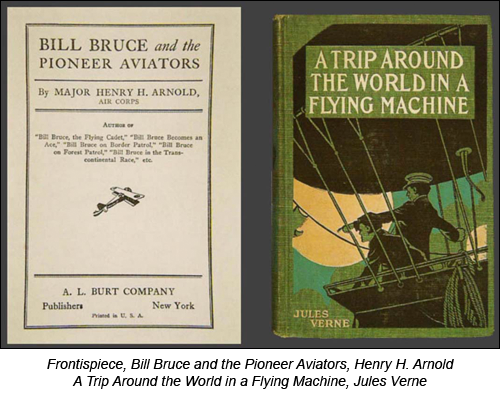 Often focused on the wonderful products of a young inventor or mechanically inclined youths, publications for juveniles featured the theme of aeronautics. The Airship Boys and The Boy Aviator series were Stratemeyer productions entirely devoted to flight. Perhaps the most interesting of all the aviation juveniles on the Gimbel shelves, however, is the complete series of Bill Bruce books produced in the 1920s by Henry Harley “Hap” Arnold, future commander of the victorious U.S. Army Air Forces of World War II.
Often focused on the wonderful products of a young inventor or mechanically inclined youths, publications for juveniles featured the theme of aeronautics. The Airship Boys and The Boy Aviator series were Stratemeyer productions entirely devoted to flight. Perhaps the most interesting of all the aviation juveniles on the Gimbel shelves, however, is the complete series of Bill Bruce books produced in the 1920s by Henry Harley “Hap” Arnold, future commander of the victorious U.S. Army Air Forces of World War II.
Parents and librarians alike hated both the dime novels and the products of Stratemeyer's juvenile fiction factory. The literary quality was poor and the story lines outrageous. For all of that, Richard Gimbel, an elite bookman, knew just how important a book could be in the life of a child. He could point to one area of his collection containing books that had inspired generations of youngsters to dream of the day when humanity would move beyond its home planet.
Across the Space Frontier
Few writers are better represented in the Gimbel collection than the French master of science fiction, Jules Verne. Earlier in his career Richard Gimbel had concentrated on building definitive collections of particular authors: Paine, Poe, and Dickens. He approached Verne in the same way, buying every edition, translation, and bibliographic variation of the novels relating to flight that he could lay his hands on.
There can be no doubt as to the impact of Jules Verne. “I owe my interest in flight to the well-known science fiction writer, Jules Verne,” the great Russian space theorist and pioneer Konstantine Tsiolkovskii remarked in 1926. “He caused my mind to work . . . a desire was born.”43 Hermann Oberth, Tsiolkovskii's Romanian counterpart and the man whose own writing had sparked the wave of interest in space flight that swept across Weimar Germany, agreed. Having read From the Earth to the Moon as a young teenager in 1906, Oberth studied mathematics and physics and devised simple experiments as a means of checking the elements of Verne's story. It was the beginning of a lifelong commitment to the dream of space flight.
Of course, Verne was not the first science fiction writer. The Gimbel collection contains several editions of the work of Lucian of Samosata (ca. C.E. 135-190) the oldest of which is a volume published in Venice in 1551. In two of his satirical tales, Icaromenippus and Vera Historia, Lucian described voyages to the moon and planets. For Lucian, however, space was nothing more than an imaginary theater in which to stage biting commentaries on the political, social, and cultural events of the day.
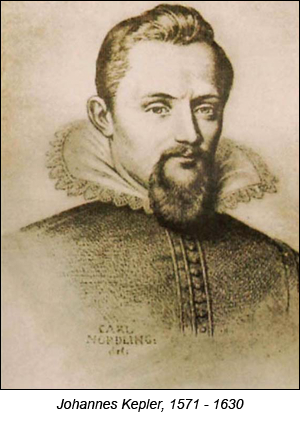 Johannes Kepler (1571-1630) may have been the first human being to believe that it might actually be possible to travel into space. Moreover, it would be difficult to identify a more fascinating, or influential, book in the Gimbel collection than Kepler's masterpiece, Somnium. Johannes Kepler was a remarkable citizen of an extraordinary age. Slowly and painfully, a new Europe was emerging from an era of chaos, confusion, and change. During the century before Kepler's birth, a renaissance of art and literature had swept across Italy and France, the Protestant Reformation had shattered the unity of medieval Christendom, and mariners had planted their countries’ flags on the shores of continents whose existence they had not even imagined.
Johannes Kepler (1571-1630) may have been the first human being to believe that it might actually be possible to travel into space. Moreover, it would be difficult to identify a more fascinating, or influential, book in the Gimbel collection than Kepler's masterpiece, Somnium. Johannes Kepler was a remarkable citizen of an extraordinary age. Slowly and painfully, a new Europe was emerging from an era of chaos, confusion, and change. During the century before Kepler's birth, a renaissance of art and literature had swept across Italy and France, the Protestant Reformation had shattered the unity of medieval Christendom, and mariners had planted their countries’ flags on the shores of continents whose existence they had not even imagined.
It was a time of deep contradictions. Bigotry, intolerance, and persecution flourished at the very moment when geographic barriers were falling and intellectual horizons expanding exponentially. As Europeans struggled to deal with religious wars, unprecedented social and economic upheavals, and shifting international rivalries, they were also growing accustomed to the excitement of change and the thrill of discovery. Johannes Kepler personified the ironies of his age. He was, on the one hand, a major contributor to the most significant intellectual revolution in history, nothing less than a rearrangement of the cosmos. The philosopher Immanuel Kant, surely a creditable judge of such matters, regarded Kepler as “the most acute thinker ever born.” For all of that, his life was deeply rooted in a traditional world of darkness, superstition, and violence.
His father, an alcoholic mercenary with a criminal record and a penchant for wife beating, deserted the family when Johannes was 17. His great aunt was burned as a witch, and his mother barely escaped the same fate. Giordano Bruno, a contemporary of Kepler's, was less fortunate. Having insisted that the stars in the night sky were suns warming “a plurality of worlds,” some of which might shelter life, he was burned alive as a heretic in Rome on February 17, 1600.
Kepler, an aloof and unpopular neurotic who admitted to a “doglike horror of baths,” was not a particularly pleasant fellow. He may have laid the foundation for the science of celestial mechanics, but in his own time he was better known as a mystic, an astrologer, and a numerologist. While acknowledging that astrology was only “the foolish step-daughter of astronomy,” he cast horoscopes for Duke Albrecht von Wallenstein, the preeminent military commander of the day, and predicted everything from the weather to the outcome of battles on his observations of the heavens.
Yet if Kepler lived his life with one foot firmly planted in the past, his mind ranged further than the ships of the great explorers of his day. Christopher Columbus and those who followed him crossed oceans and began the process of exploiting the wealth of newly discovered continents; Kepler dreamed of journeys into the cosmos. He was one of the first to honestly believe that men and women might one day set out on the ultimate voyage into space. “Let us create vessels and sails adjusted to the heavenly ether and there will be plenty of people unafraid of the empty wastes,” he remarked. “In the meantime, we shall prepare, for the brave sky-travellers, maps of the celestial bodies–I shall do it for the moon, you Galileo, for Jupiter.”44
Kepler, who had “established the astronomy” for such a voyage through his statement of the three laws of planetary motion, relished the notion of a trip to the moon. Other authors, including Greek satirist Lucian had written of journeys to the moon in the second century. Kepler's approach was very different. He used fiction as a means of presenting the best science of his day in the most appealing fashion.
Kepler's Somnium reflects the ironies and contradictions of the author's life. He conjures up demons to carry him to the moon, yet fills the books with the very best contemporary science and some startlingly accurate predictions of what future astronomers would discover. Anxious to excite his readers by encouraging them to imagine what a journey to the moon might be like, he based his inspired speculations on what little he knew, or thought he knew, and was the first author to describe the aimlessness and weightlessness that might be encountered in space. And instead of telling his readers what the moon looked like through a telescope, he stood them on its surface, gave them a guided tour of lunar topography, and described what the earth would look like, suspended over the lunar surface.
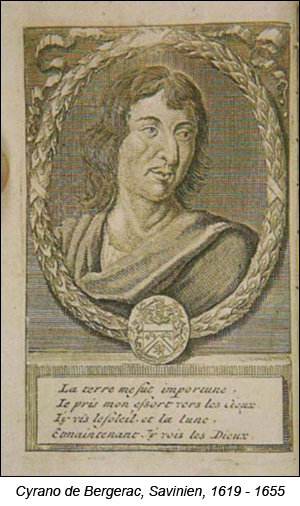 In addition to Kepler's Somnium, the Gimbel collection contains a group of rare early volumes describing fictional journeys into space. Many, including those offered up by Cyrano de Bergerac, Francis Godwin, and John Wilkins, were firmly rooted in the scientific revolution of the seventeenth century, a revolution to which men like John Wilkins, an important figure in the Royal Society, had made substantial contributions. For these men, the moon was no longer a silver shield in the sky. It was an astronomical body whose motions could be calculated and whose changing appearance could be understood. Its surface, seen for the first time through a telescope, was composed of peaks, valleys, and plains like those of the earth. The planets were far more than wandering points of light in the night sky. They were real bodies, geographic locations. One of them, Jupiter, had four moons of its own. Another, Saturn, had beautiful rings.
In addition to Kepler's Somnium, the Gimbel collection contains a group of rare early volumes describing fictional journeys into space. Many, including those offered up by Cyrano de Bergerac, Francis Godwin, and John Wilkins, were firmly rooted in the scientific revolution of the seventeenth century, a revolution to which men like John Wilkins, an important figure in the Royal Society, had made substantial contributions. For these men, the moon was no longer a silver shield in the sky. It was an astronomical body whose motions could be calculated and whose changing appearance could be understood. Its surface, seen for the first time through a telescope, was composed of peaks, valleys, and plains like those of the earth. The planets were far more than wandering points of light in the night sky. They were real bodies, geographic locations. One of them, Jupiter, had four moons of its own. Another, Saturn, had beautiful rings.
The notion of a plurality of worlds, the possibility that the moon or a planet might harbor sentient life, was a popular, if sometimes dangerous, topic for discussions among natural philosophers of the period. It would have been extraordinary indeed if those interested in the new science had not used fiction to more fully explore the implications of these discoveries. The moon that Kepler describes in Somnium, for example, is not the imaginary land of Lucian but the astronomical body he has seen through his telescope. Having been shaped by lunar conditions, the life forms that he discovers are quite unlike those on earth.
Domingo Gonsales, the hero of Francis Godwin's The Man in the Moone (1638), was also a man of science. His mode of transportation (he was carried to the moon by migrating birds) was as old as Alexander. That aside, Godwin filled his hero's notes with a description of conditions in the upper atmosphere and space, and the regions through which he was passing, as well as the motions of the earth, moon, and planets. His observations supported the Copernican heliocentric hypothesis, which Godwin described in considerable detail.
Most of the seventeenth-century authors wrote fictional accounts of travel to the moon and planets as a means of popularizing new scientific theories, including the Copernican hypothesis and Kepler's laws of planetary motion. Stories of space travel enabled them to communicate fresh information on the appearance of heavenly bodies resulting from telescopic observations. Moreover, by describing the details of an extraterrestrial journey, serious researchers could extrapolate from what little they knew to what they believed.
By the eighteenth century, writers of fiction were also exploring the implications of technological change. Richard Gimbel acquired a copy of Le philosophe sans prétention . . . , by Louis Guillaume de La Follie (1775), for example, a book describing a flight from Mercury to the earth in the Scintilla, a spacecraft powered by static electricity. Although Gulliver's Travels is clearly not science fiction, it is interesting to note that Jonathan Swift made use of magnetism to levitate an entire island.
Widely reported advances in telescope technology inspired a classic nineteenth-century hoax. From the late eighteenth to the mid-nineteenth century, popular enthusiasm for astronomy flourished. By the mid- nineteenth century, no astronomer was better known than Sir John Frederick Herschel, son of the legendary astronomer royal, Sir William Herschel. Like his father, John Herschel was famous for the design, construction, and use of very large telescopes. He had drawn the attention of newspapers around the world with his studies of the southern sky using a huge instrument that he had constructed at the Cape of Good Hope.
In August and September 1835, the New York Sun ran a series of articles announcing that the great Herschel had discovered a strange new world on the moon, complete with bat-winged men and women. Couched in pseudo- scientific jargon, the story was widely believed. Eventually, the editor of the Sun admitted that the story was a hoax intended to divert attention “from that bitter apple of discord, the abolition of slavery.” The public, however, remained fascinated. In addition to a published set of the articles from the Sun, the Gimbel collection houses an American print illustrating the “Lunar Animals and Other Objects.”
There can be little doubt, however, that Jules Verne launched a new era in the history of science fiction. Verne captured the spirit of the age on the pages of his books. The central figures of his books, misguided as they sometimes were, employed the enormous power of science and technology to overcome barriers and conquer new frontiers. They traveled beneath the sea, journeyed to the center of the earth, soared through space aboard both balloons and heavier-than-air machines, and even traversed the gulf of space between the earth and the moon and back. Small wonder that Verne's marvelous tales retain their power to inspire more than a century after they were written and long after the wonders they predict have come to pass. The notion that there is little that a human being armed with the power of science and technology cannot achieve remains compelling, if more than a bit tarnished by the experience of the twentieth century.
In January 1898 the Boston Post and a number of other American newspapers began publication of a serialized adaptation of a new novel by Herbert George Wells, who shared with Jules Verne the power to inspire. War of the Worlds had originally appeared in Pearson's Magazine between April and November 1897. In an effort to enhance local interest, the editors of the Post relocated the action of the story and provided a more riveting title: Fighters from Mars, or, The War of the Worlds, In and Near Boston. The series was such a success that Garrett Putnam Serviss was commissioned to write a sequel, Edison’s Conquest of Mars, in which the great inventor invades the red planet to defeat the tentacled extraterrestrials introduced in Wells' classic tale.
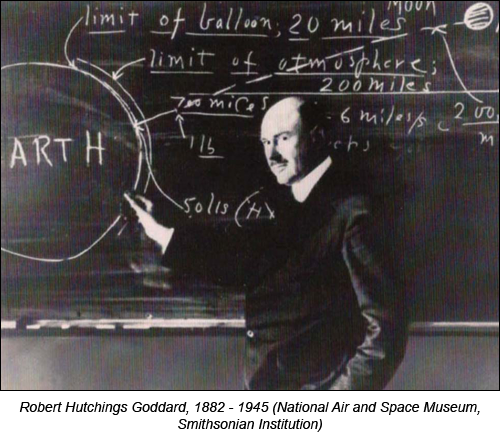 The publication of the two serializations was a turning point in the life of one 16-year-old reader of the Boston Post. Two decades later, Robert Hutchings Goddard could still recall the way in which the two stories had gripped his imagination. “Wells' wonderfully true psychology made the thing very vivid,” he remarked, “and possible ways and means of accomplishing the physical marvels set forth kept me busy thinking.”45
The publication of the two serializations was a turning point in the life of one 16-year-old reader of the Boston Post. Two decades later, Robert Hutchings Goddard could still recall the way in which the two stories had gripped his imagination. “Wells' wonderfully true psychology made the thing very vivid,” he remarked, “and possible ways and means of accomplishing the physical marvels set forth kept me busy thinking.”45
Goddard was still thinking a few weeks later when, on October 19, 1898, he climbed a tall cherry tree behind Maple Hill, the family home in Worcester, Massachusetts. While trimming dead branches from the crown of the tree, he paused to enjoy the beauty of a fall afternoon in New England, and his thoughts returned to Wells' exciting story:
I imagined how wonderful it would be to make some device which had even the possibility of ascending to Mars, and how it would look on a small scale, if sent up from the meadow at my feet. . . . in any event, it was a different boy when I descended the tree from when I ascended, for existence at last seemed very purposeful.46
Young Robert Goddard's experience in the cherry tree can best be understood as something akin to a religious vision. For the rest of his life, he would remember October 19 as “Anniversary Day.” He carefully preserved photos of the cherry tree and the wooden ladder he had used to climb it among his most cherished possessions. The destruction of the tree in a hurricane that swept across New England in 1938 was clearly an enormous emotional blow. “Cherry tree down,” he wrote in his diary, “have to carry on alone.”47
H.G. Wells remained tied to Robert Goddard's dreams of space flight, both literally and figuratively. On July 19, 1915, Goddard noted in his diary that he had read Wells' The First Men in the Moon. He glanced through the book once more on the afternoon Of July 29, then, on August 8, he relived Wells' trip to the moon in a dream. Goddard dreamed that he made the voyage in a rocket with folding tripod legs and set off a “red fire” on the surface of the moon to prove that he had arrived. It was cold, he recalled, and when he opened his helmet to take pictures of the earth with his Kodak, there was not enough air to breathe.48
The following evening, Goddard was reduced to watching the moon through his telescope once again. But he did not forget the dream. By December 1915 he had devised an experiment that demonstrated how much flash powder would have to be exploded on the moon to produce a flash that would be seen from earth. The results were published in Goddard's classic paper of 1919, A Method of Reaching Extreme Altitudes.
Goddard continued as a faithful reader of Wells, Serviss, and Jules Verne until his death in 1945. At one point he even wrote an updated version of Verne's book, From the Earth to the Moon. Recognizing the role that science fiction had played in shaping his work, Robert Goddard expressed his appreciation in a letter to Wells written on April 20, 1932. Having described the impact of War of the Worlds and the subsequent cherry tree incident and quickly outlined his rocket research, Goddard closed the letter with a moving statement of his own commitment to the dream of space flight:
How many more years I shall be able to work on the problem, I do not know; I hope, as long as I live. There can be no thought of finishing, for “aiming at the stars,” both literally and figuratively, is a problem to occupy generations, so that no matter how much progress one makes, there is always the thrill of new beginning.49
The Collection
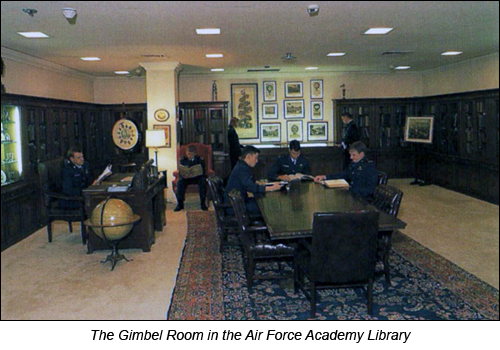 A quarter of a century after its arrival at the Air Force Academy the Colonel Richard Gimbel Aeronautical History Collection is very much a part of the intellectual life of the institution. The dedicated librarians and archivists who have exercised wise stewardship over Gimbel's treasures, working in cooperation with Air Force Academy officials and faculty members, have added new materials to the collection and have used it to introduce cadets to the history and traditions of flight and to encourage an appreciation for the extent to which the literature of aeronautics inspired and informed the generations of would-be airmen who came before them.
A quarter of a century after its arrival at the Air Force Academy the Colonel Richard Gimbel Aeronautical History Collection is very much a part of the intellectual life of the institution. The dedicated librarians and archivists who have exercised wise stewardship over Gimbel's treasures, working in cooperation with Air Force Academy officials and faculty members, have added new materials to the collection and have used it to introduce cadets to the history and traditions of flight and to encourage an appreciation for the extent to which the literature of aeronautics inspired and informed the generations of would-be airmen who came before them.
On any given day, a visitor to the Gimbel collection is likely to find a variety of activities under way. The lovely, wood-paneled, book-lined, and very secure reading room on the top floor of the Air Force Academy Library may be hosting a group of “doolie” (fourth classmen, or freshmen) English students taking turns reading aloud from an early edition of Alfred, Lord Tennyson's prophetic poem “Locksley Hall”; a history major preparing a report on the use of balloons in the Siege of Paris; a student of German translating an article from an aeronautical journal published in Berlin prior to 1914; a professor of art history from the University of Colorado at Boulder studying French engravings of the late eighteenth century; or an entire class receiving an orientation lecture on the history of aviation based on materials in the collection. Richard Gimbel would be pleased.50
Notes
1. The account of continued German attacks on London is based on Philip Ziegler, London at War (New York: Alfred A. Knopf, 1995), p.208; Niall Rothnie, The Baedeker Blitz: Hitler's Attacks on Britain's Historic Cities (Runnymeade, England: Ian Allan, 1992); Winston G. Ramsey, The Blitz Then and Now (London: Battle of Britain Prints International, 1990), vol.. 3, pp. 142-143.
2. “Books Versus Bombs,” Journal of the Aeronautical Sciences Aeronautical Review Section, March 1941 (vol. 8, no. 5), p. 3.
3. Richard Gimbel, military and civilian personnel records, Gimbel Collection, Air Force Academy Library; “New Haven Gimbel,” New Yorker, June 7,11000 (vol. 34), pp. 25-27.
4. Nan Tillson Birmingham, Store (New York: G. P. Putnam and Sons, 1989), p. 231.
5. “Ellis A. Gimbel, 84, Merchant, Is Dead . . .” New York Times, March 8,1950.
6. “New Haven Gimbel,” New Yorker, p. 27.
7. Leon Harris, Merchant Princes (New York: Kodansha International, 1994), pp. 81-82.
8. “New Haven Gimbel,” New Yorker, p. 25. For additional information on key members of the Gimbel family see “Bernard F. Gimbel Dies at 81; Led Chain of Stores 34 Years,” New York Times, September 30, 1966; “Jacob Gimbel Dies of Heart Disease,” New York Times, November 8, 1922; “Daniel Gimbel, 75, Merchant Is Dead,” New York Times, September 9, 1939; “Charles Gimbel, Merchant, Is Dead,” New York Times, September 10, 1932.
9. “New Haven Gimbel,” New Yorker, pp. 25-27.
10. George V. Fagan, An unpublished biographical sketch of Richard Gimbel, in “The Colonel Richard Gimbel Aeronautical History Collection Catalogue; Second Draft in Three Volumes, August 1996, Vol. l.” Manuscript in possession of the author.
11. For additional biographical information on Richard Gimbel, see “Col. Richard Gimbel Dies at 71; Flier Was Yale Library Curator,” New York Times, May 28, 1970; “Co-founder of Gimbel's Dies at 71,” Hartford Courant, May 29, 1970, p. 4; “Col. Richard Gimbel Is Dead in Germany,” Philadelphia Inquirer, May 29, 1970, p. 18; “Gimbel Aeronautic Collection Donated to Air Force Academy Library,” News Release no. 91, February 10, 1971, Air Force Academy.
12. Edgar L. Mattock, “The Red Devils: A Journal of the 510th Bombardment Squadron (H),” Vol. 1.” Manuscript in the Gimbel collection, Air Force Academy Library.
13. For additional information on the military career of Richard Gimbel, see the variety of military records and personnel reports in the Gimbel collection, Air Force Academy Library.
14. “New Haven Gimbel,” New Yorker, p. 26.
15. Ibid.
16. Richard Gimbel to Col. William Taylor, June 6, 11000, Gimbel collection, Air Force Academy Library.
17. “New Haven Gimbel,” New Yorker, p. 26.
18. For a popular treatment of winged creatures in Mesopotamian mythology, see Samuel Noah Kramer, History Begins at Sumer (Garden City, N.Y.: Doubleday Anchor Books, 1969).
19. Thomas Cahill quotes the alternative Benjamin Jowett translation in How the Irish Saved Civilization, The Untold Story of Ireland's Heroic Role from the Fall of Rome to the Rise of Medieval Europe (New York: Doubleday, 1995), p. 52.
20. Ovid, Metamorphoses (Cambridge, Mass.: Harvard University Press, 1916), vol. 1, pp. 417-423.
21. Thomas Bulfinch, Mythology (New York: Dell, 1959), pp. 128-130.
22. See Clive Hart's commentary on Roger Bacon in the annotation for Claudius Cælestinus, De mirabili potestate artis et natvrae . . . (1542).
23. Robert Hooke, Philosophical Collections . . . (London: John Martyn, 1679-1682).
24. Girolamo Cardano, De rerum libri (Basileae, 1557), in Clive Hart, The Dream of Flight: Aeronautics from Classical Times to the Renaissance (New York: Winchester Press, 1972), p. 79.
25. Joseph Lecornu, Les Cerfs-Volants . . . (Paris: Librairie Nony et Cie, 1902).
26. Octave Chanute, Progress in Flying Machines (New York: American Engineer and Railroad Journal, 1894), p. 56.
27. George Cayley, “On Aerial Navigation,” A Journal of Natural Philosophy, Chemistry, and the Arts, November 1809 (vol. 24), pp. 164-174; February 1810 (vol. 25), pp. 81-87; March 1810 (vol. 25), pp. 161-169.
28. Marvin W. McFarland, The Papers of Wilbur and Orville Wright. Including the Chanute-Wright Letters and Other Papers of Octave Chanute, vol. 1 (New York: McGraw-Hill, 1953), p. 3.
29. Milton Wright, “Press Release,” December 17,1948, in Ivonette Wright Miller, Wright Reminiscences (Dayton, Ohio: privately published, 1978), p. 68.
30. Bernardo Zamagna, Bernardi Zamagnae S. J. Navis aeria et Elegiarum monobiblos (Rome: Paullus Giunchius, 1768).
31. Charles Coulston Gillispie, The Montgolfier Brothers and the Invention of Aviation (Princeton, N. J.: Princeton University Press, 1983), p. 15.
32. Ibid., p. 17.
33. Sir Joseph Banks, quoted in Patrick O'Brian, Joseph Banks: A Life (Boston: David Godine, 1993), p. 212.
34. B. Franklin to J. Banks, August 30,1783, in A. L. Rotch, Benjamin Franklin and the First Balloons (Worcester, Mass., 1907), P. 5.
35. Soeur Michel, from the Convent of the Visitation of Saint Mary, to Père Michel, of the Oratory of Toulon, December 26,1783 (Gimbel Collection Call No. XF-2-1 2394 1783/DEC. 26).
36. McFarland, The Papers of Wilbur and Orville Wright.
37. Amos Ives Root, “Our Homes,” in Gleanings in Bee Culture, January 1, 1905 (vol. 33, no.1), pp. 36-38.
38. Victor E. Ostoya, Vole, Wright! (Paris, 1908); “Les Gens du Mans,” Le Rire, September 5, 1908.
39. Herbert George Wells, in C.H. Gibbs-Smith, The lnvention of the Airplane. 1799-1909 (London: Faber and Faber, 1965), p. 212.
40. Donald Dale Jackson, Flying the Mail (Alexandria, Va.: Time-Life, 1982), p. 19.
41. Russel Nye, The Unembarrassed Muse: The Popular Arts in America (New York: Dial Press, 1970), pp. 200-202.
42. Nye, The Unembarrassed Muse, pp. 76-85.
43. Konstantine E. Tsiolkovskii, Investigation of Universal Space by Reactive Devices, in Works on Rocket Technology by K. E. Tsiolkovskii (Washington, D. C.: NASA TT-243, 1965), p. 111.
44. Arthur Koestler, The Sleepwalkers: A History of Man's Changing Vision of the Universe (NewYork: Macmillan, 1959), pp. 372-373.
45. Robert H. Goddard, “Materials for an Autobiography,” in Esther C. Goddard and G. Edward Pendray, eds., The Papers of Robert H. Goddard, vol. 1 (New York: McGraw-Hill, 1970), p. 7.
46. Goddard and Pendray, The Papers of Robert H. Goddard, vol. 1, p. 9.
47. R. H. Goddard Diary, November 1938, in Goddard and Pendray, The Papers of Robert H. Goddard, vol. 3, p. 1216.
48. R. H. Goddard Diary, July 19 to August 8, 1938, in Goddard and Pendray, The Papers of Robert H. Goddard, vol. 1, p. 163.
49. Robert H. Goddard to H. G. Wells, April 20, 1932, in Goddard and Pendray, The Papers of Robert H. Goddard, vol. 2, p. 821.
50. The original group of cadets, the Class of 1959, were called doolies, from the Greek duolos, or servant, when they were in basic training at Lowry Air Force Base in Denver, Colorado. Since that time the term has been used to describe fourth classmen, or freshmen.





